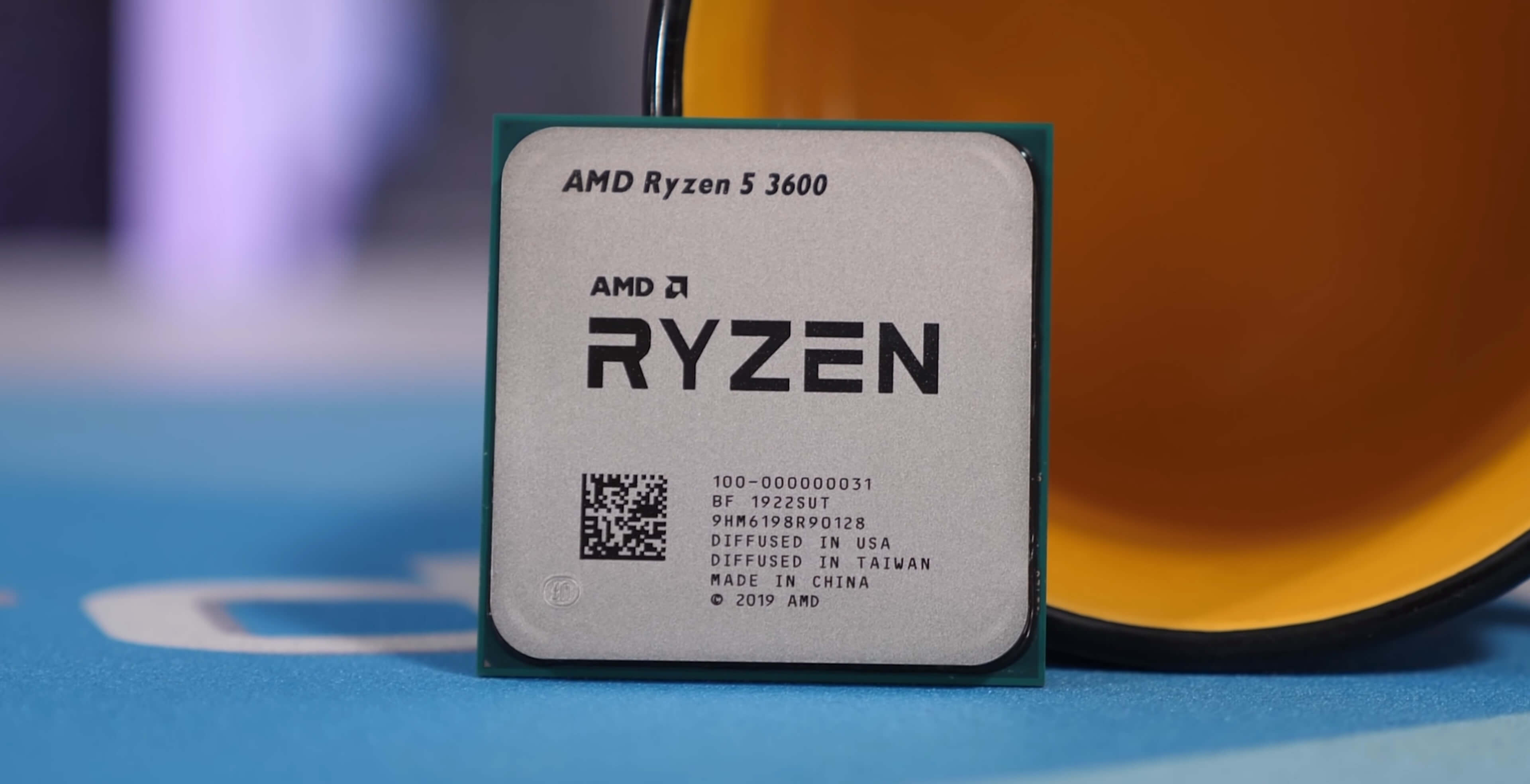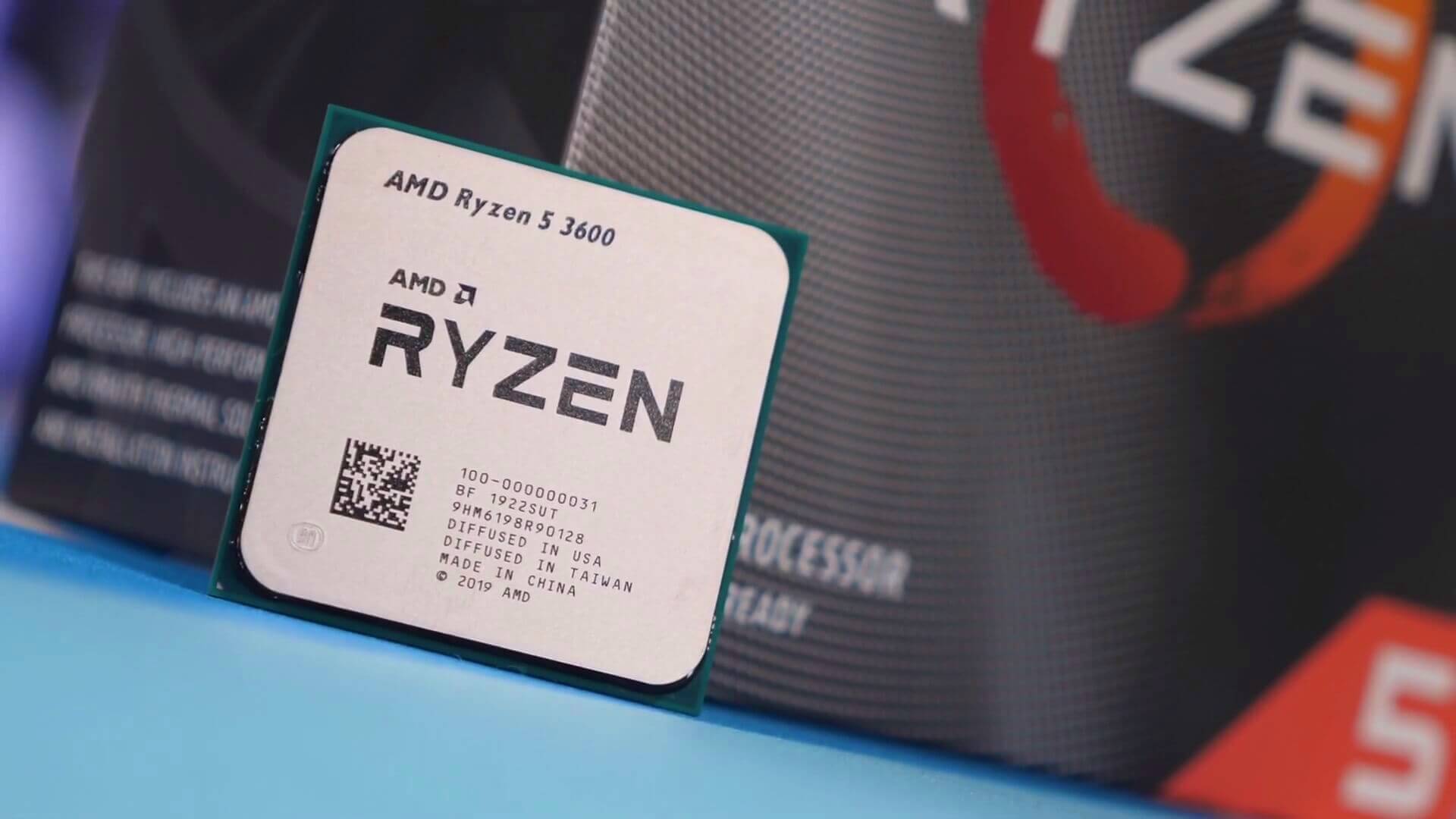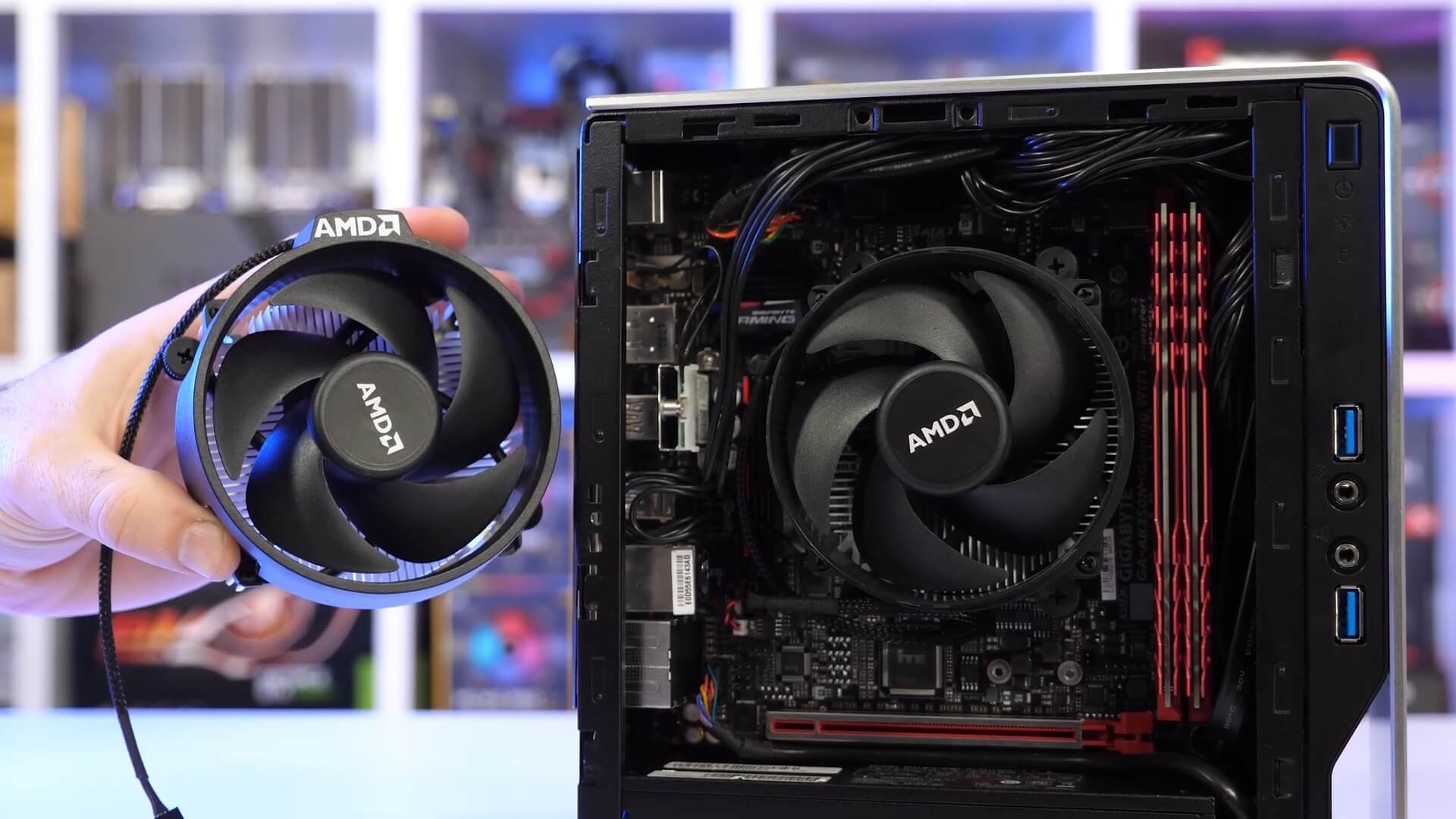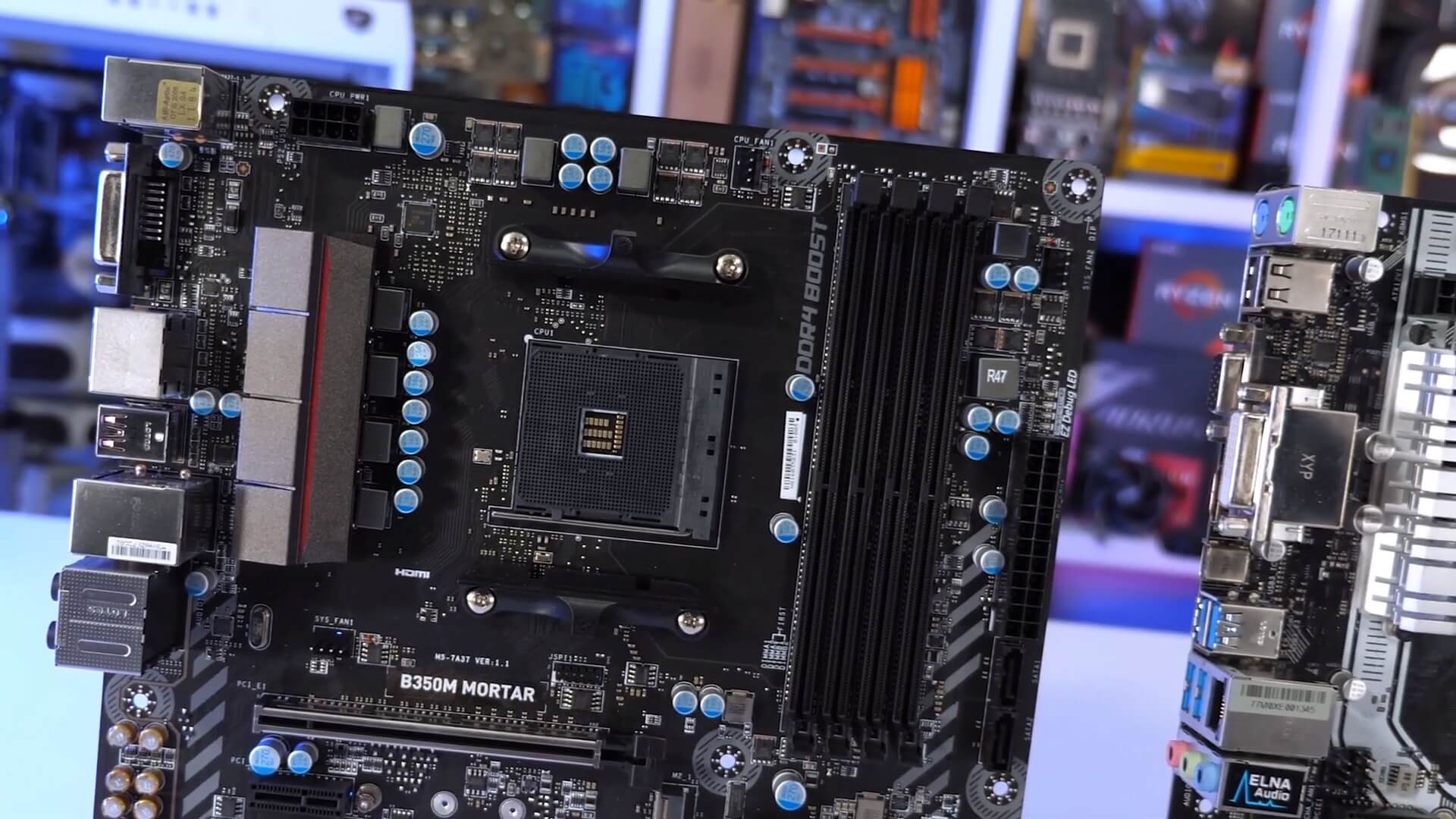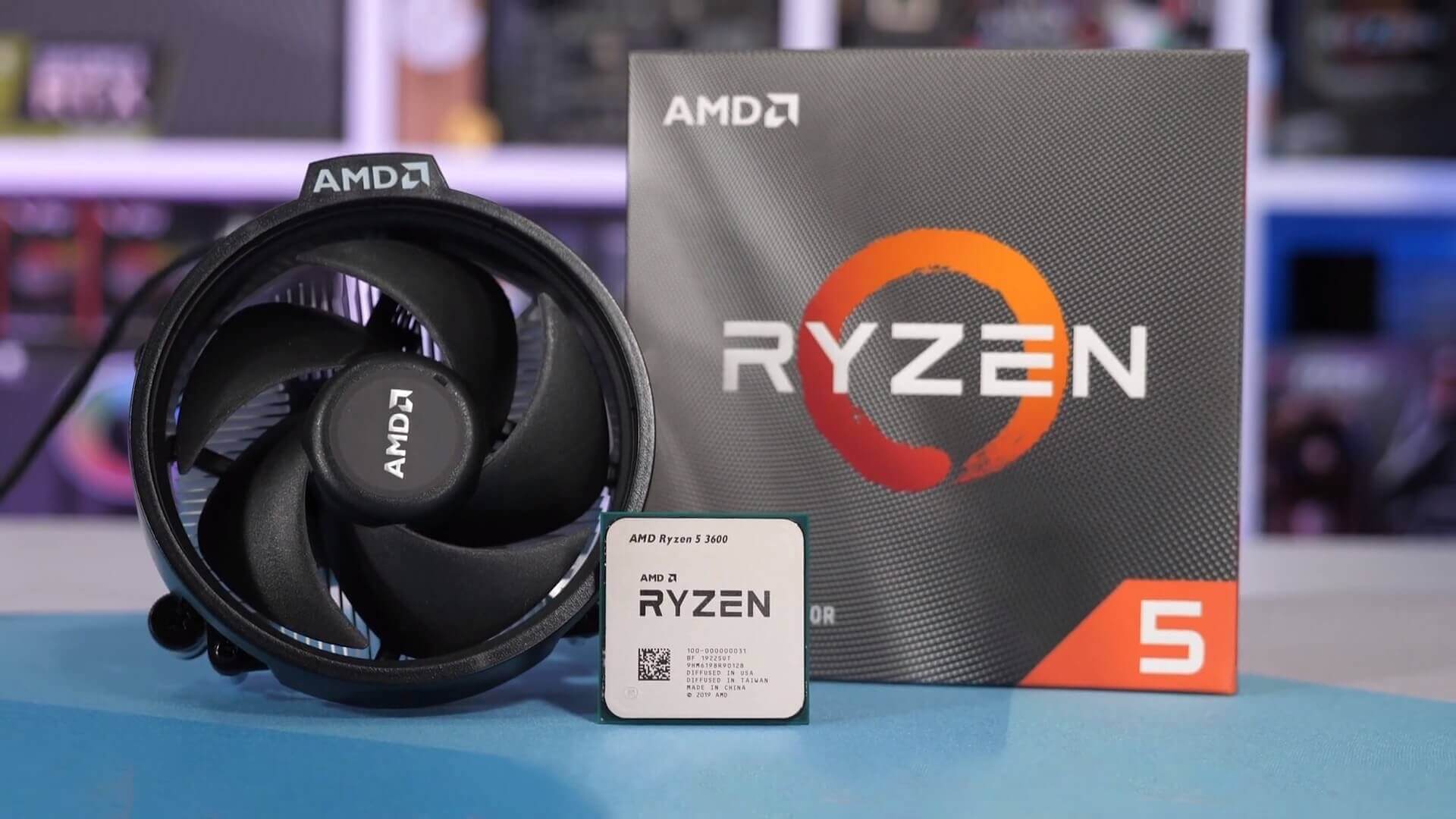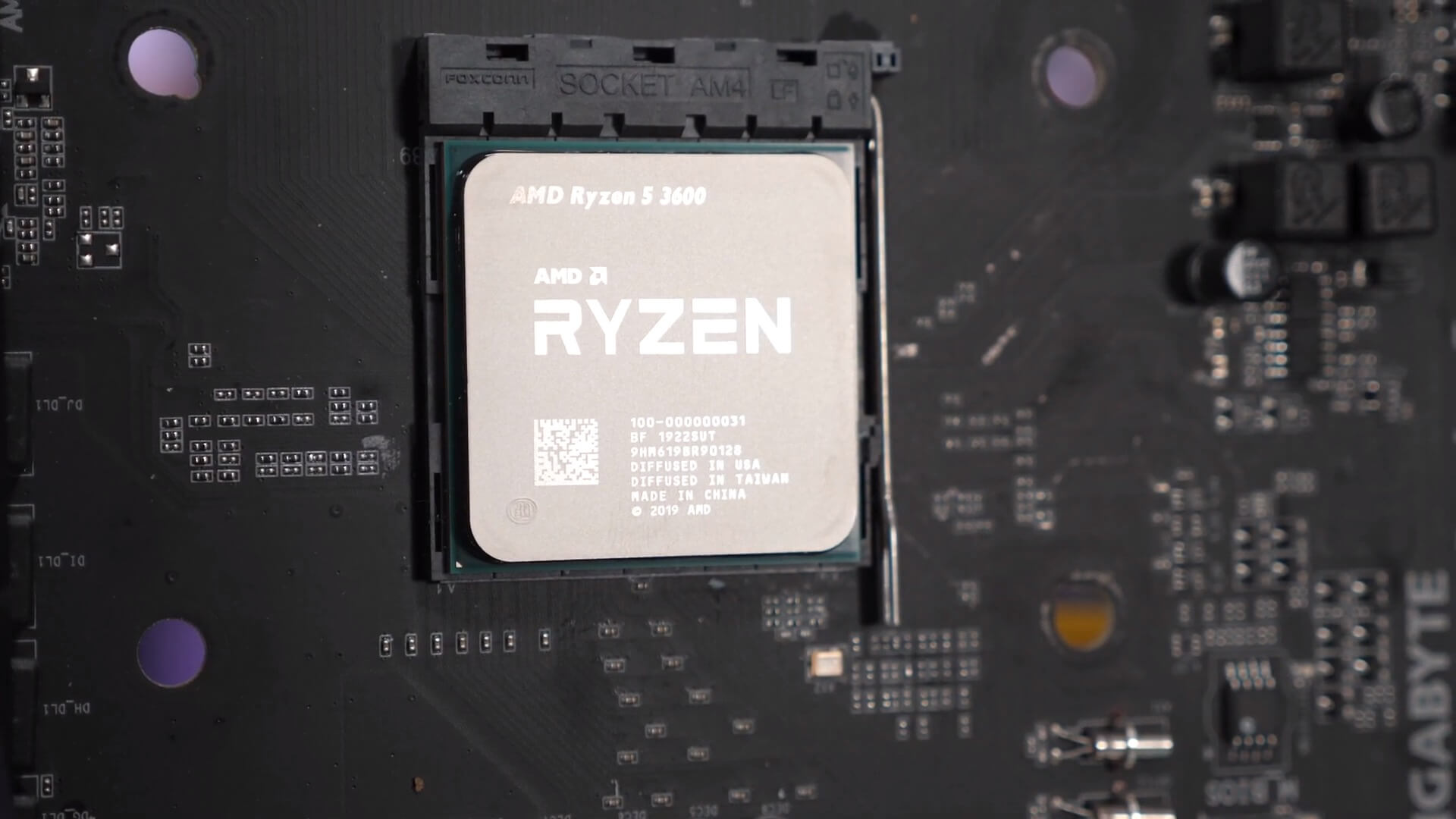The successor to our favorite best value CPU, the Ryzen 5 3600 is AMD's new $200 6-core, 12-thread processor. The chip clocks between 3.6 GHz and 4.2 GHz, features a 32MB L3 cache and a 65 watt TDP. Included in the package is the Wraith Stealth cooler and a MSRP that matches the price the R5 2600 launched at.
Direct competition for the R5 3600 should come from Intel's Core i5-9600 which is listed at $213, but we don't have that part on hand and it doesn't appear to be on sale either, so the more expensive 9600K will have to do. It costs $255 and doesn't include a box cooler, so it's not the exact match we were going for, but it will be interesting to see how they stack in terms of raw power.
For testing the new Ryzen processor we used the MSI X570 Creation, configured with DDR4-3200 CL14 memory and the stock cooler. The 8th and 9th-gen Intel Core processors were tested on the Gigabyte Z390 Aorus Ultra, using the same RAM modules, but cooled using the Corsair H115i RGB Platinum AIO liquid cooler. The Intel CPUs are not TDP restricted, so we're showing the best case scenario for out of the box performance, but we will factor in the cost of an aftermarket cooler for them when we go through our cost analysis at the end of the review. Our graphics card of choice was the MSI Trio GeForce RTX 2080 Ti.
For simplicity sake we removed a number of high-end more expensive CPUs from our performance graphs such as the R9 3900X, 9700K, 9900K, Threadripper 2920X and Core i9-7900X as they aren't relevant when looking at a $200 CPU. But you can easily cross reference the results posted today with our Ryzen 3900X and 3700X review.
Benchmarks
We'll start off with Cinebench R20's multi-core test and right away we're blown away by the R5 3600's output. Here it matched the Ryzen 7 1800X with just over 3600 pts. This made it 4% faster than the 8700K, almost 20% faster than the 2600X and 28% faster than the model it's replacing, the R5 2600.
Then when compare to the R5 1600, the new 3600 is 45% faster. That's an insane jump. In 2 years AMD has increased performance at the $200 price point by almost 50%.
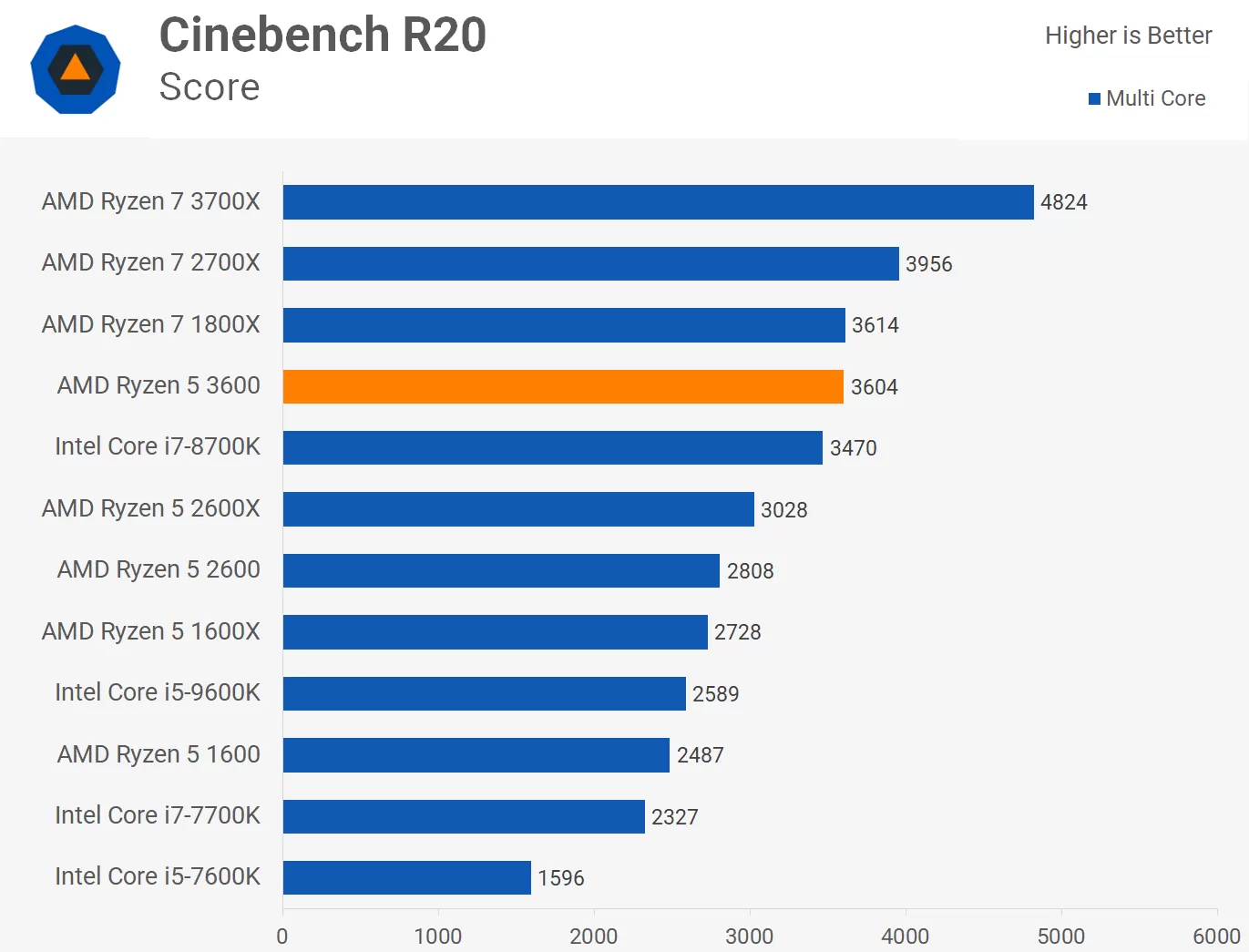
The single core performance is equally impressive, here the 3600 was just 4% slower than the 3700X and that meant it was able to match the Core i5-9600K and just edge out the 8700K.
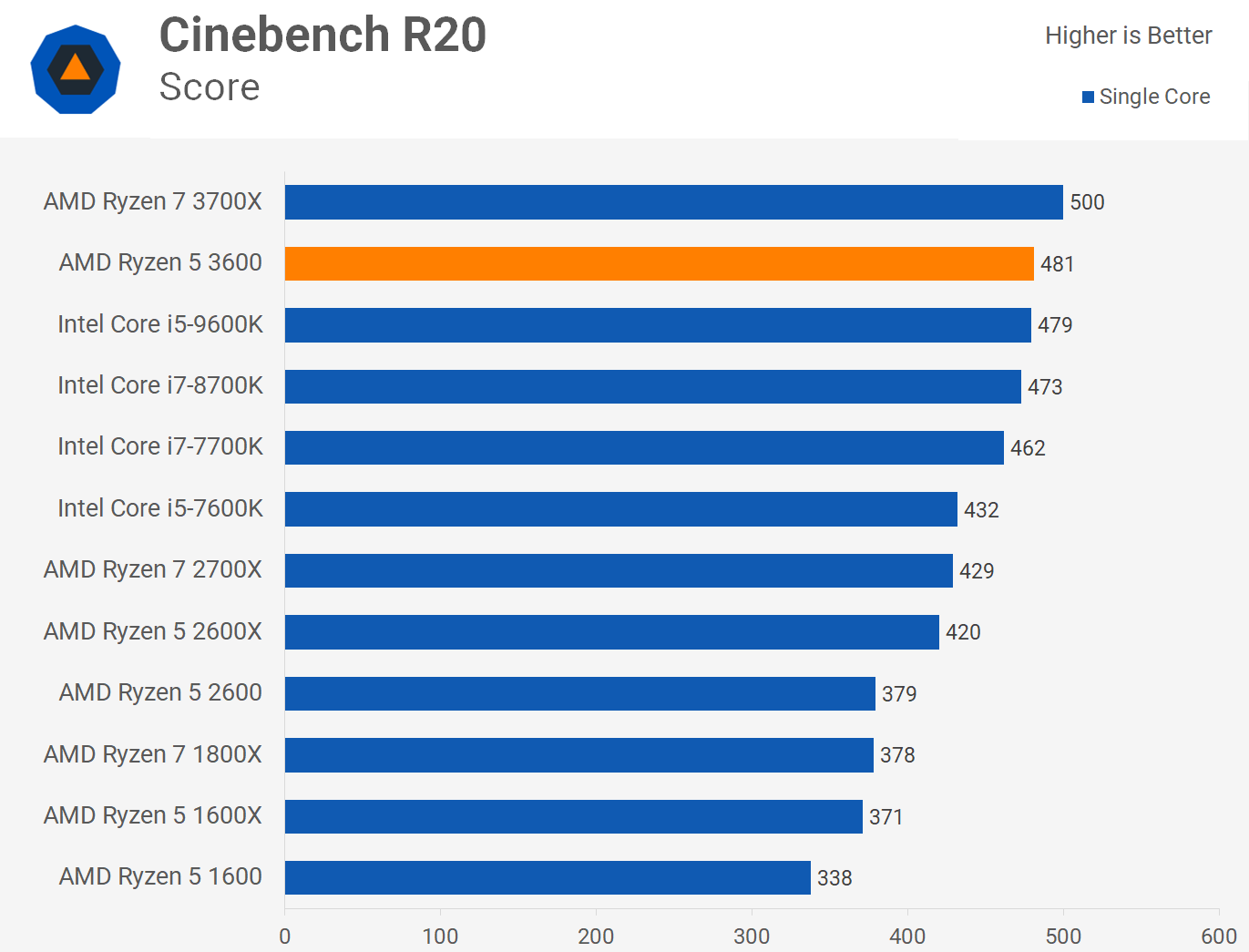
Moving on to WinRAR, the R5 3600 looks very good, falling just short of the 8700K by a mere 4% margin. That made it 45% faster than the Core i7-7700K and Ryzen 7 2700X.
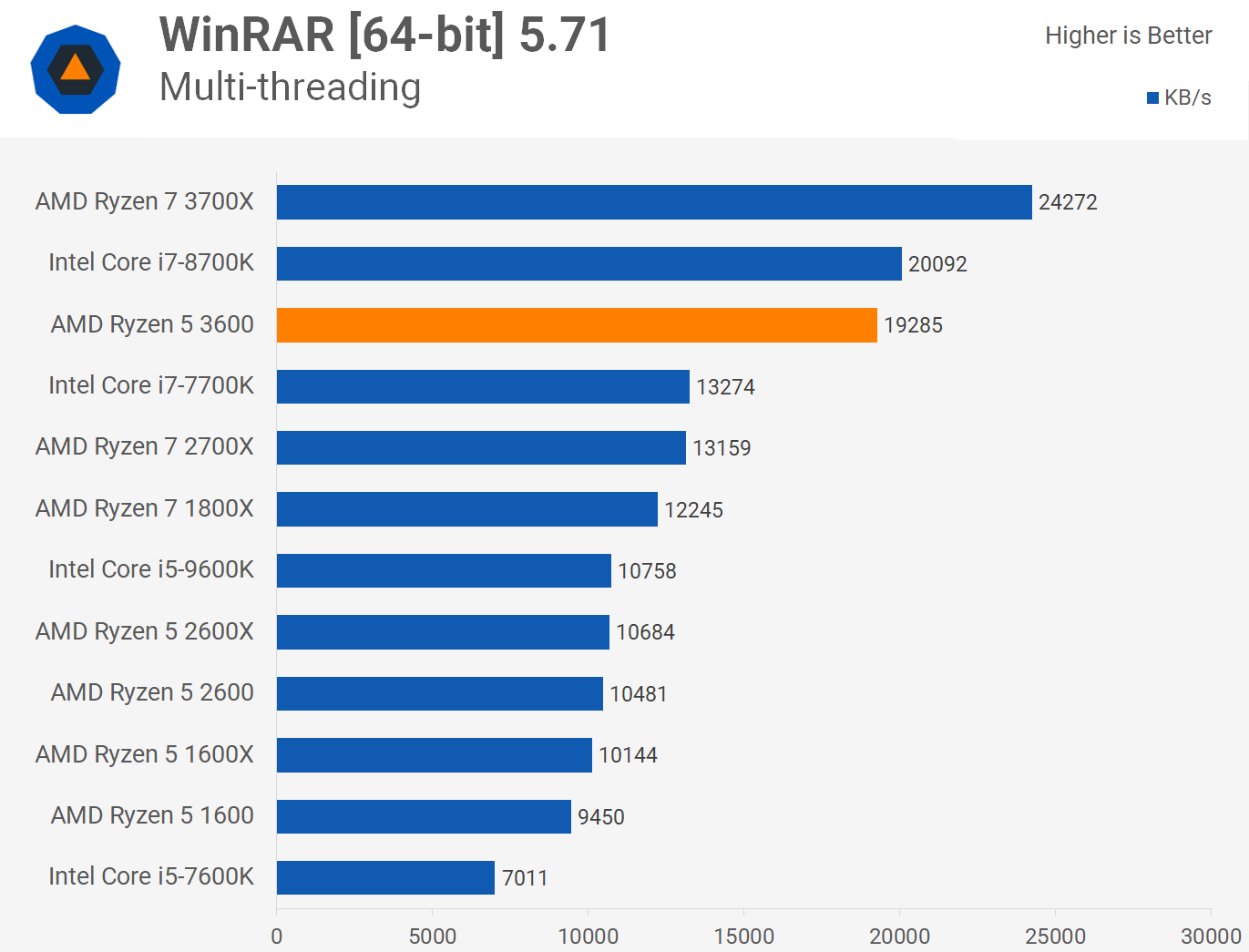
Testing with 7-zip we see the R5 3600 beating the 2700X. The compression performance is great, offering 14% more performance than the 8700K. It did fall behind the 8-core Ryzen processors in the decompression test, but even so it was still 16% faster than the 8700K.
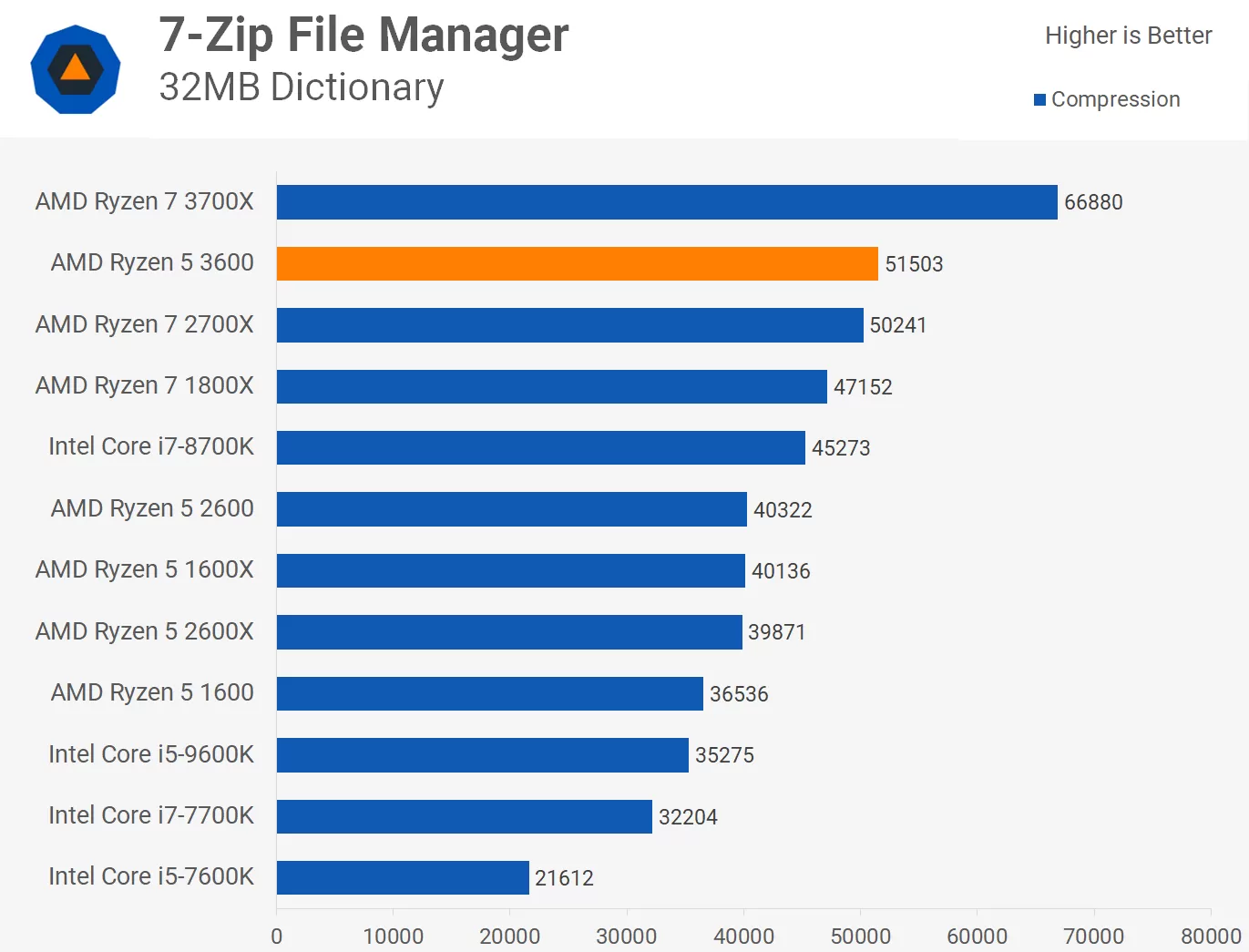
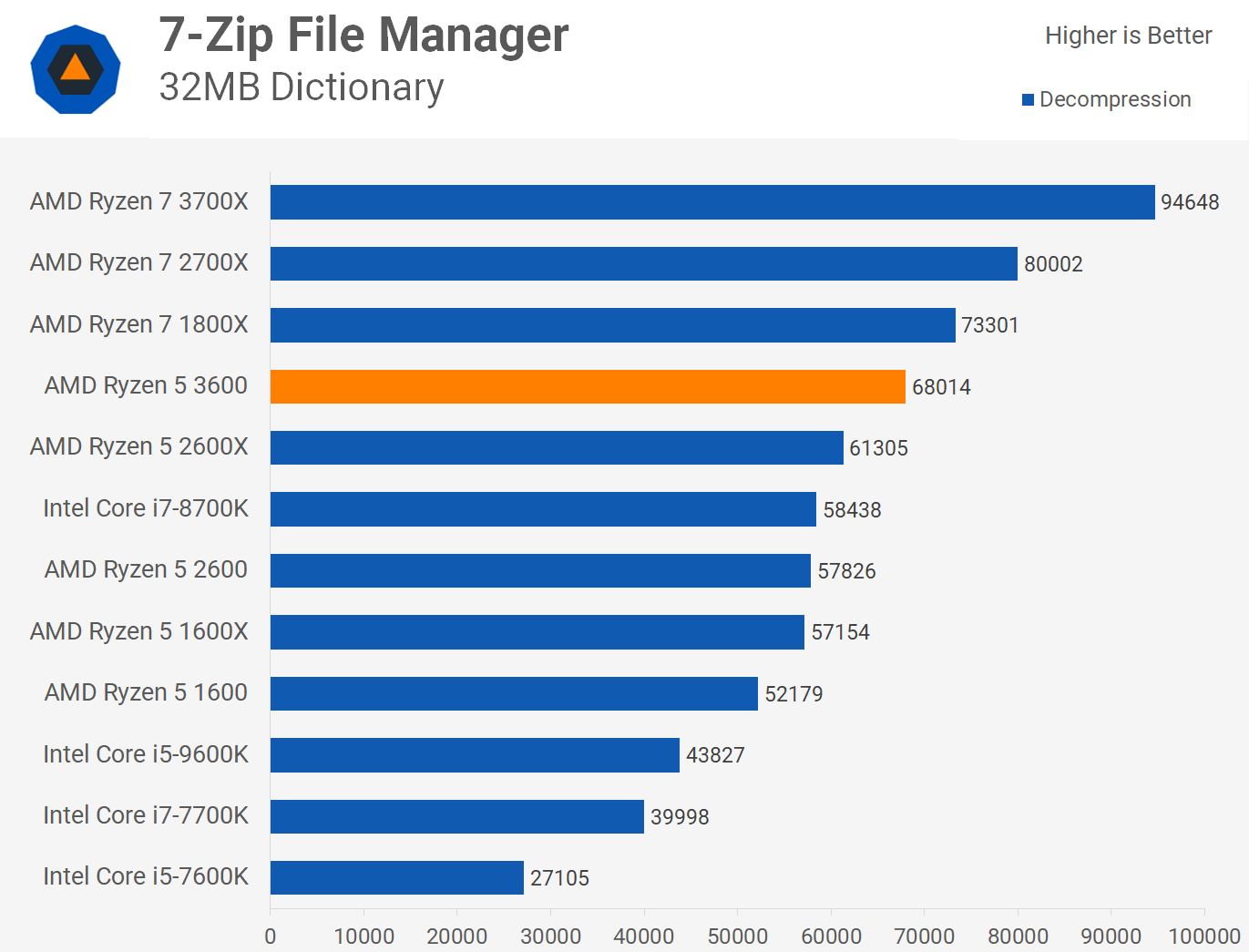
For budding content creators the Ryzen 5 3600 will be a godsend, for just $200 it completed our 4K workload 4% faster than the 8700K and while that's far from a significant margin, remember the 8700K is a $360 processor.
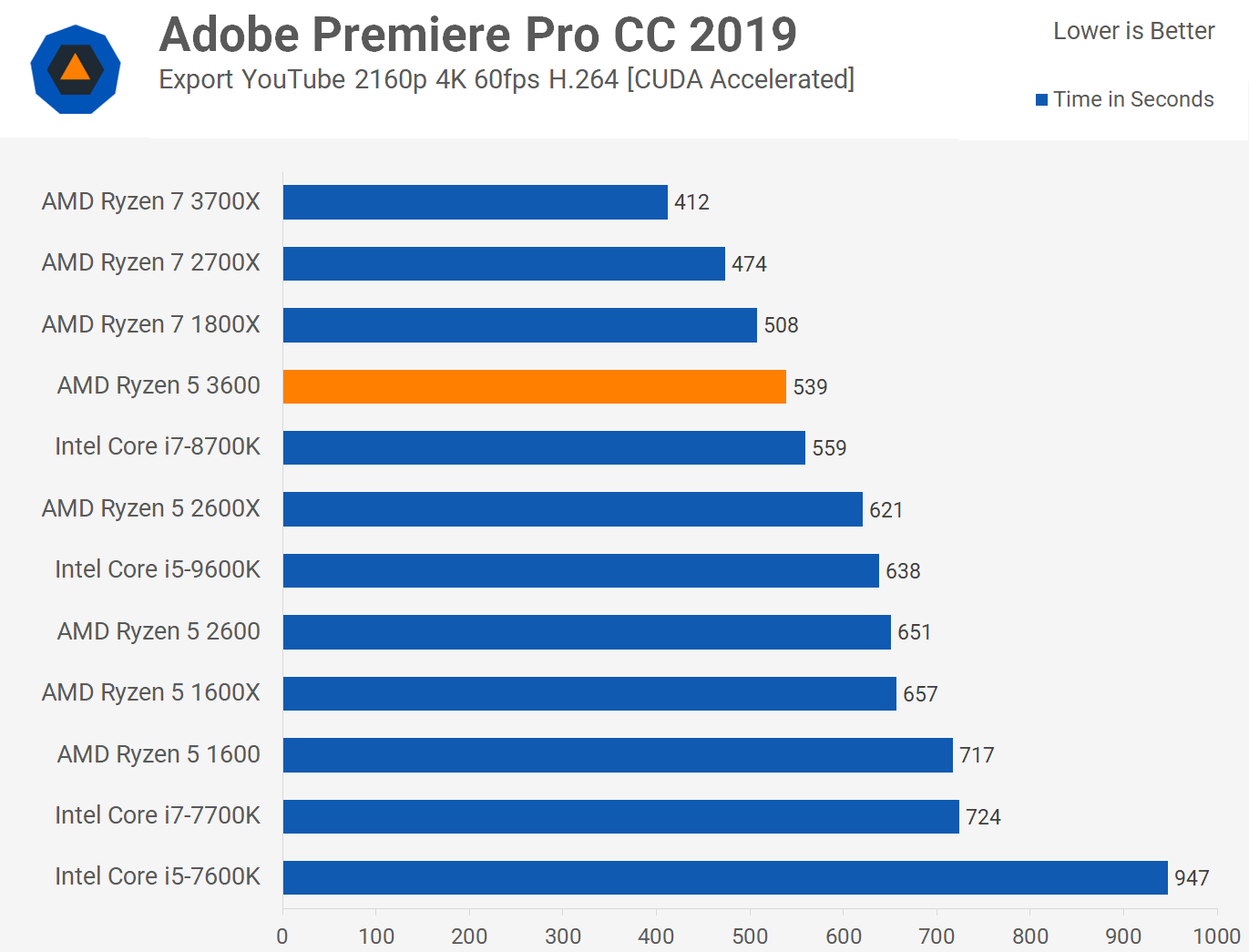
Compared to the R5 2600 it was 17% faster and a whopping 32% faster than the R5 1600 in V-Ray. The 3600 does come up short against the 8700K in the latest version of the V-Ray benchmark by a 6% margin.
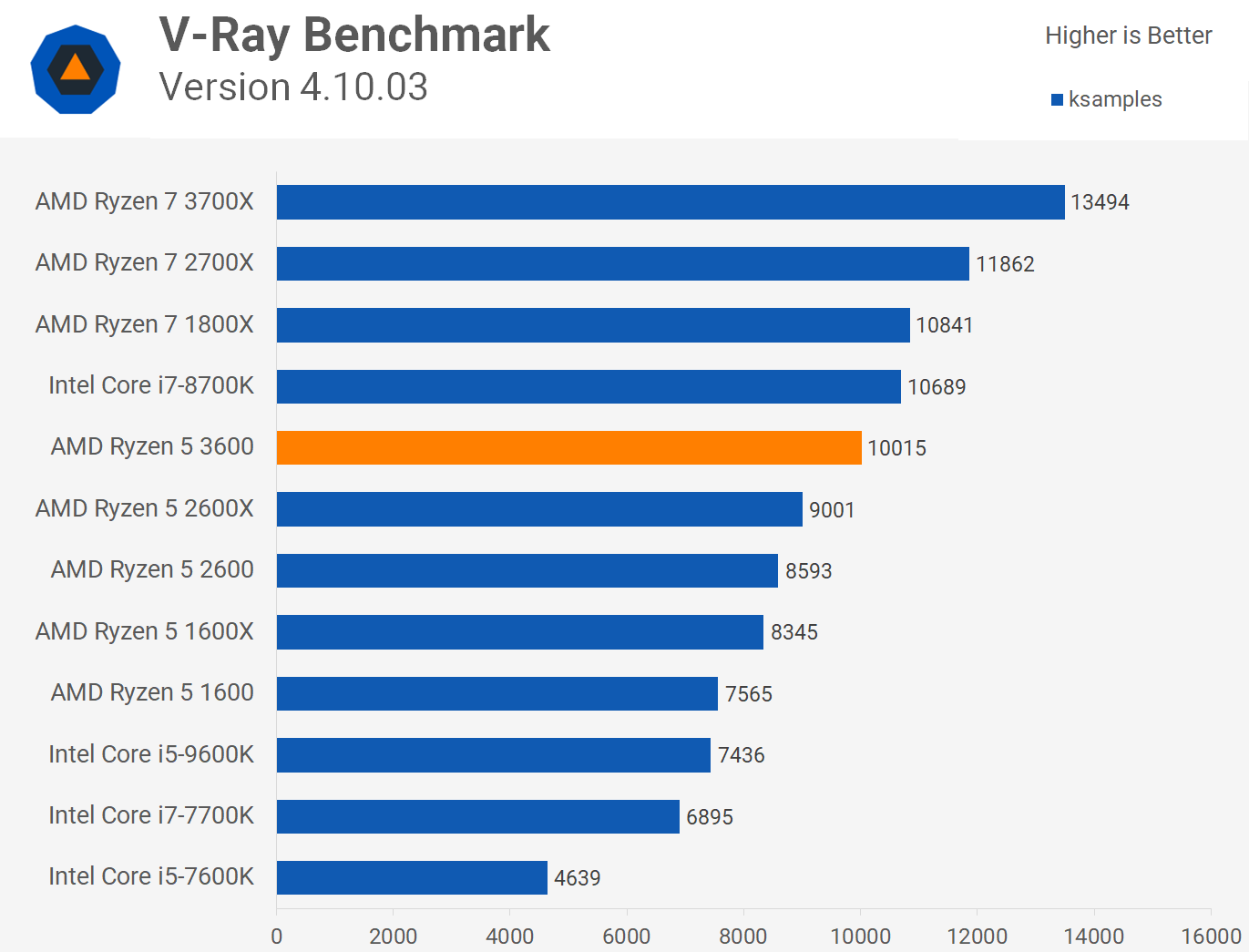
AMD's new 6-core CPU trailed the 8700K by a small margin in the Corona benchmark, but given the difference in price this remains a solid showing for the R5 3600.

The mainstream 3600 CPU managed to pull ahead on the Blender test, matching the 8700K and easily winning against the previous generation Ryzen equivalents and the 9600K that is relegated to the bottom of the table.

Power Consumption
Perhaps more impressive are the total system power consumption figures we recorded when running the Blender benchmark. As you can see the R5 3600 consumed the same amount of power as the quad-core Core i7-7700K and only slightly more than the i5-9600K.
Now you might think consuming slightly more power than the 9600K isn't that impressive, but remember, the 3600 was almost 40% faster than the Core i5 processor in this test. So in terms of power efficiency it's very impressive.

Gaming Benchmarks
Our first gaming test is Assassin's Creed: Odyssey where the R5 3600 slightly edges out the 8700K's 1% low result despite being a few frames slower on average. Still you can very much call what we see here, 8700K-like performance from the new Ryzen 5 3600.
Similar to what we saw in the R9 3900X and 3700X review, the 3rd-gen Ryzen processors slip a little in this title at 1440p and this is also true of the R5 3600. Here it's 6% slower than the 8700K, not a massive margin but normally you'd expect things to close up at 1440p.
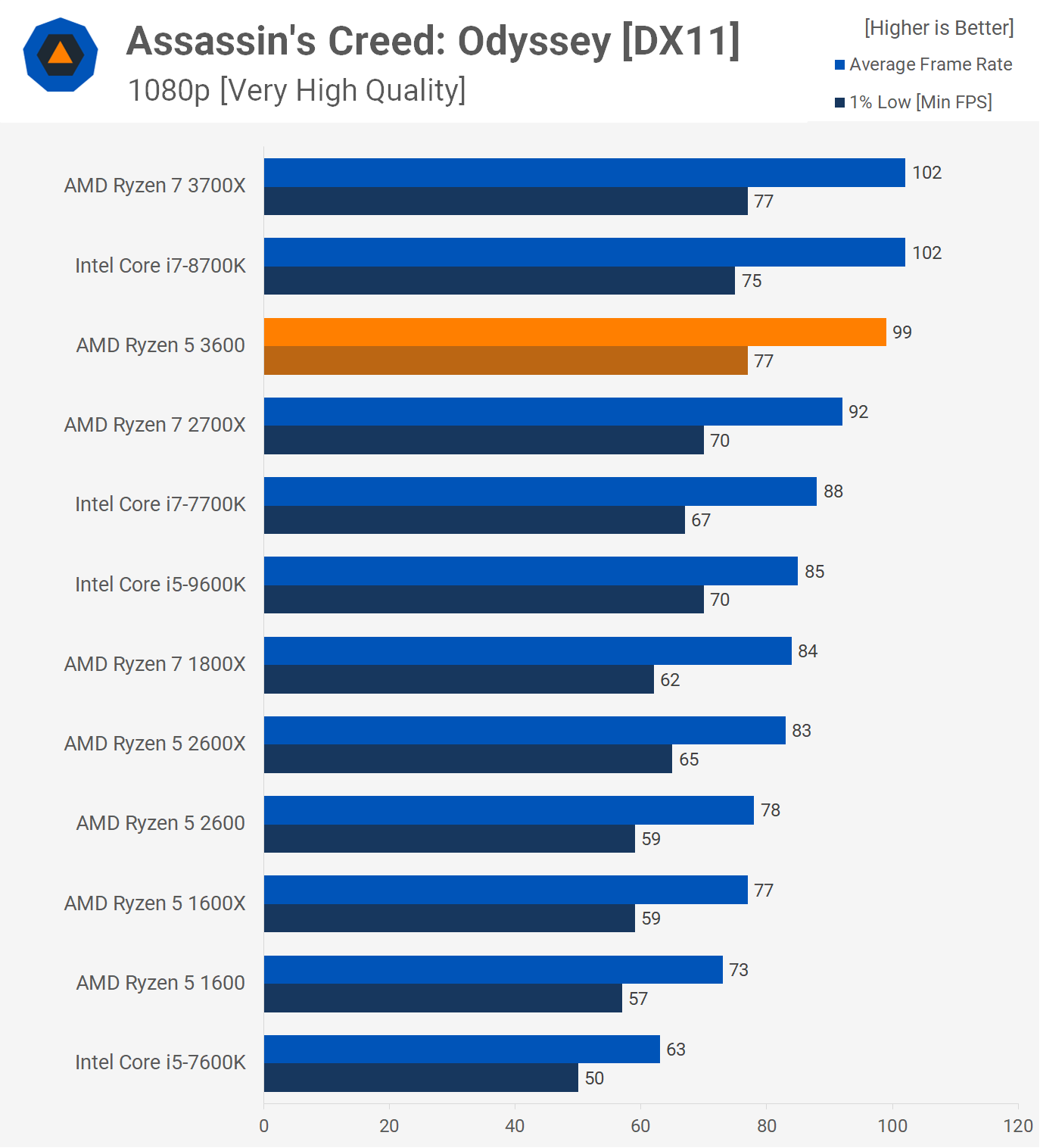
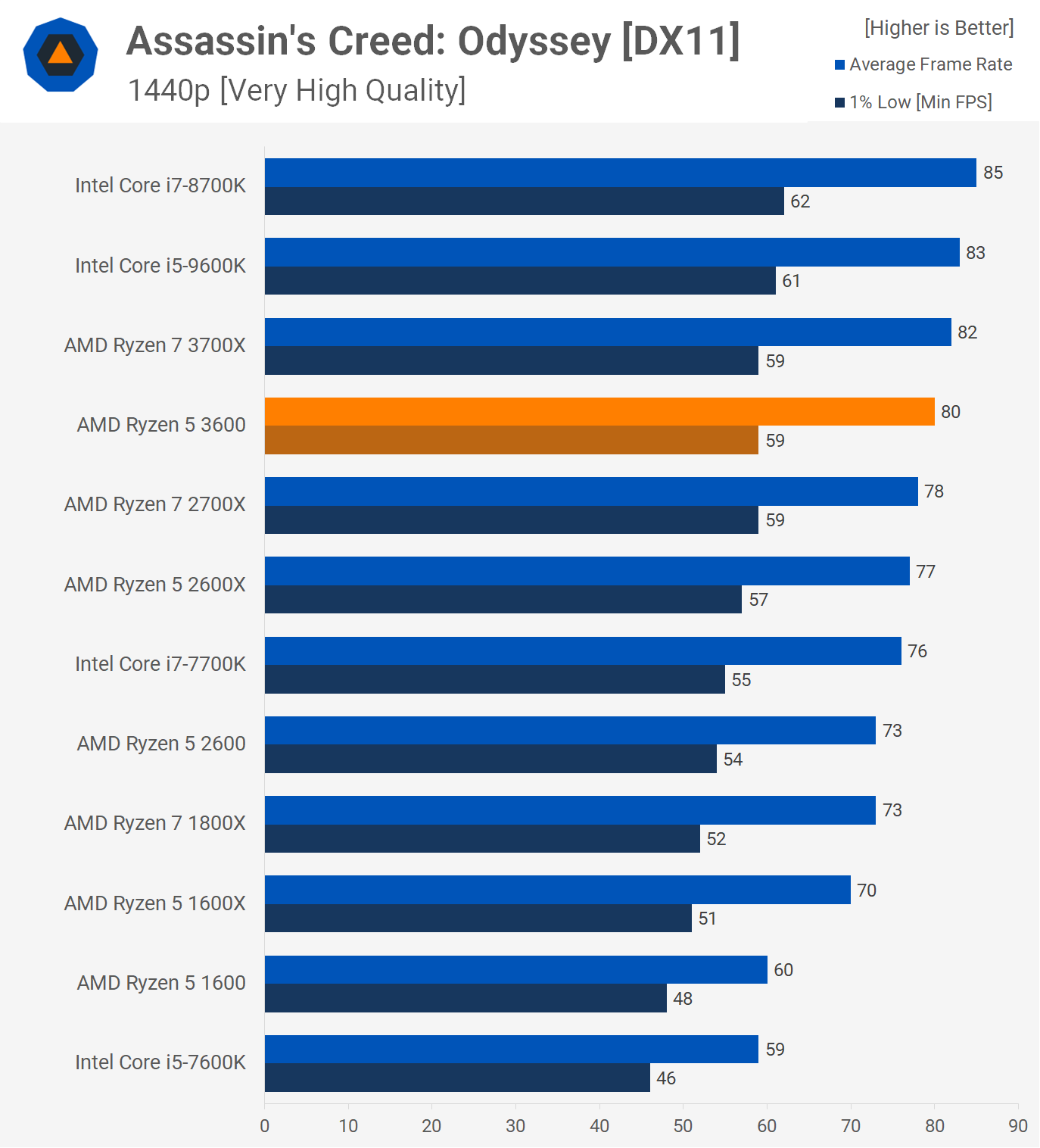
The Battlefield V results are a little disappointing, though I have to remind myself, the 3600 isn't competing with the 8700K. Its main target should be the 9600K and here it improves 1% low performance by 23%.
Even at 1440p, despite the 9600K appearing quicker when looking at the average frame rate, the 1% low performance of the 3600 was 18% higher and this allowed it to deliver a smoother and more consistent gaming experience.
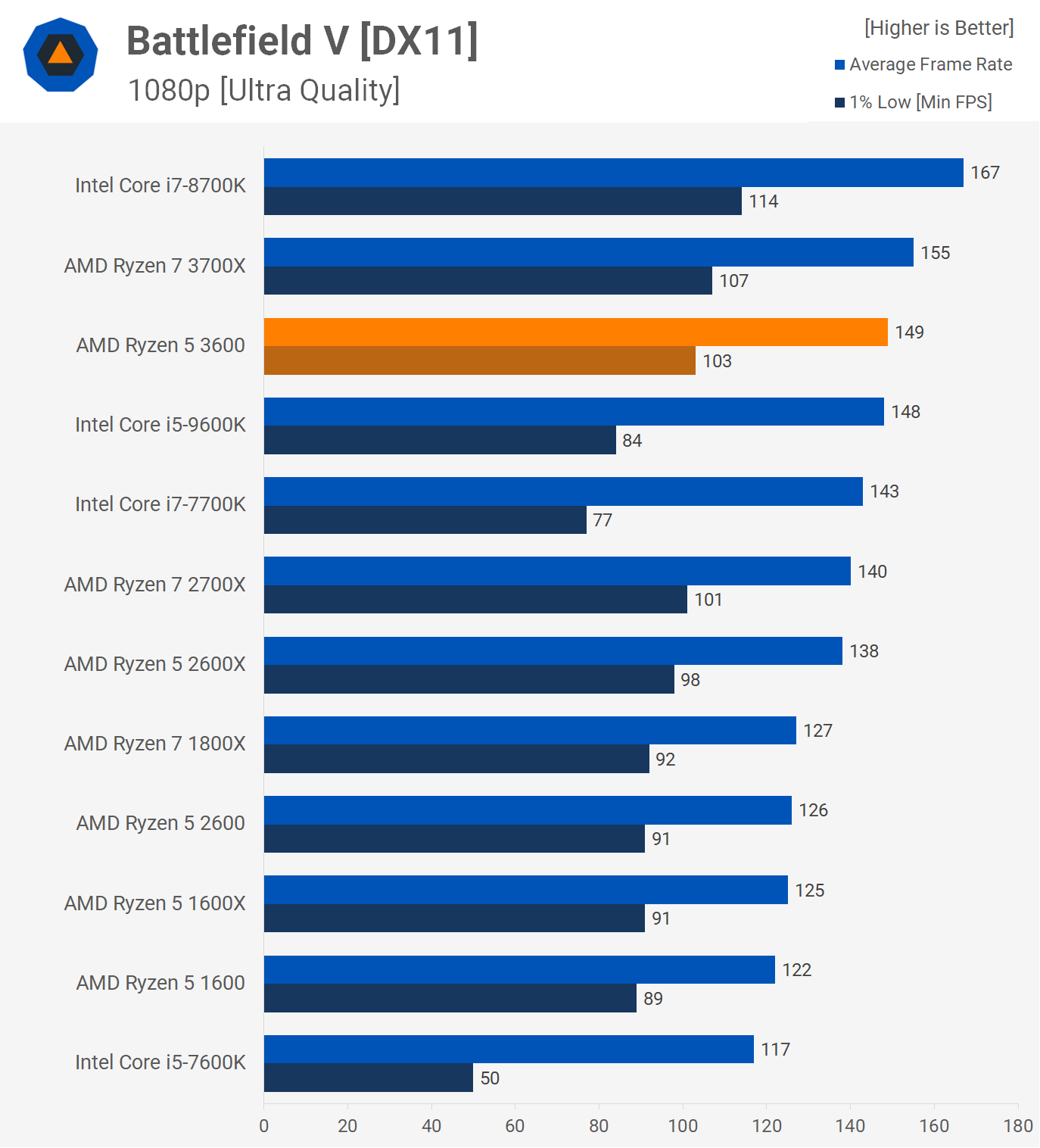
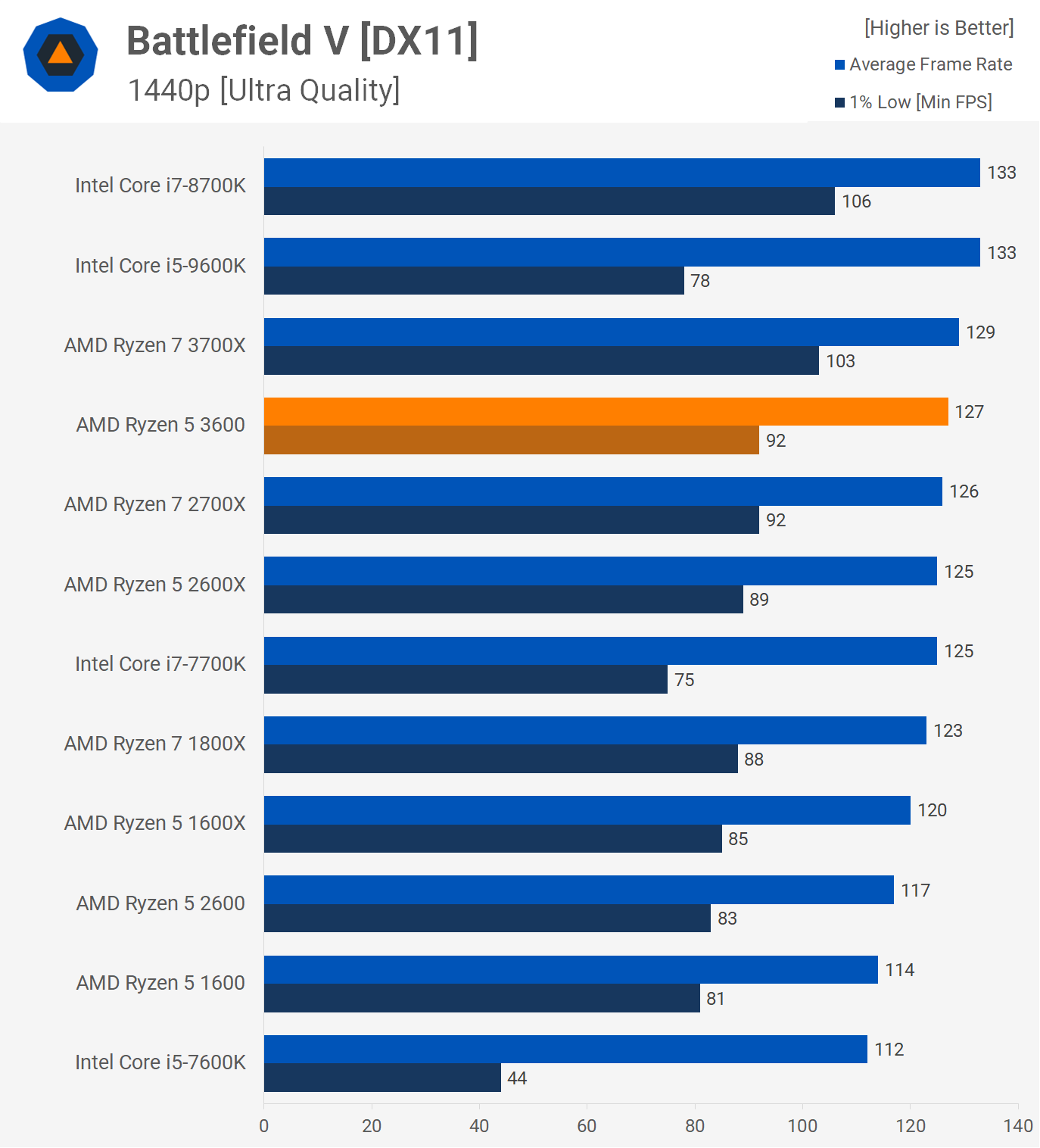
Next up we have Shadow of the Tomb Raider and here the 3600 matched the 9600K, which is a good result given the 9600K costs more. The 1440p results were much the same, the 9600K creeped ahead by a few frames but overall performance was competitive and the 1% low performance of the 3600 was a good bit faster than any of the 2nd gen Ryzen parts.
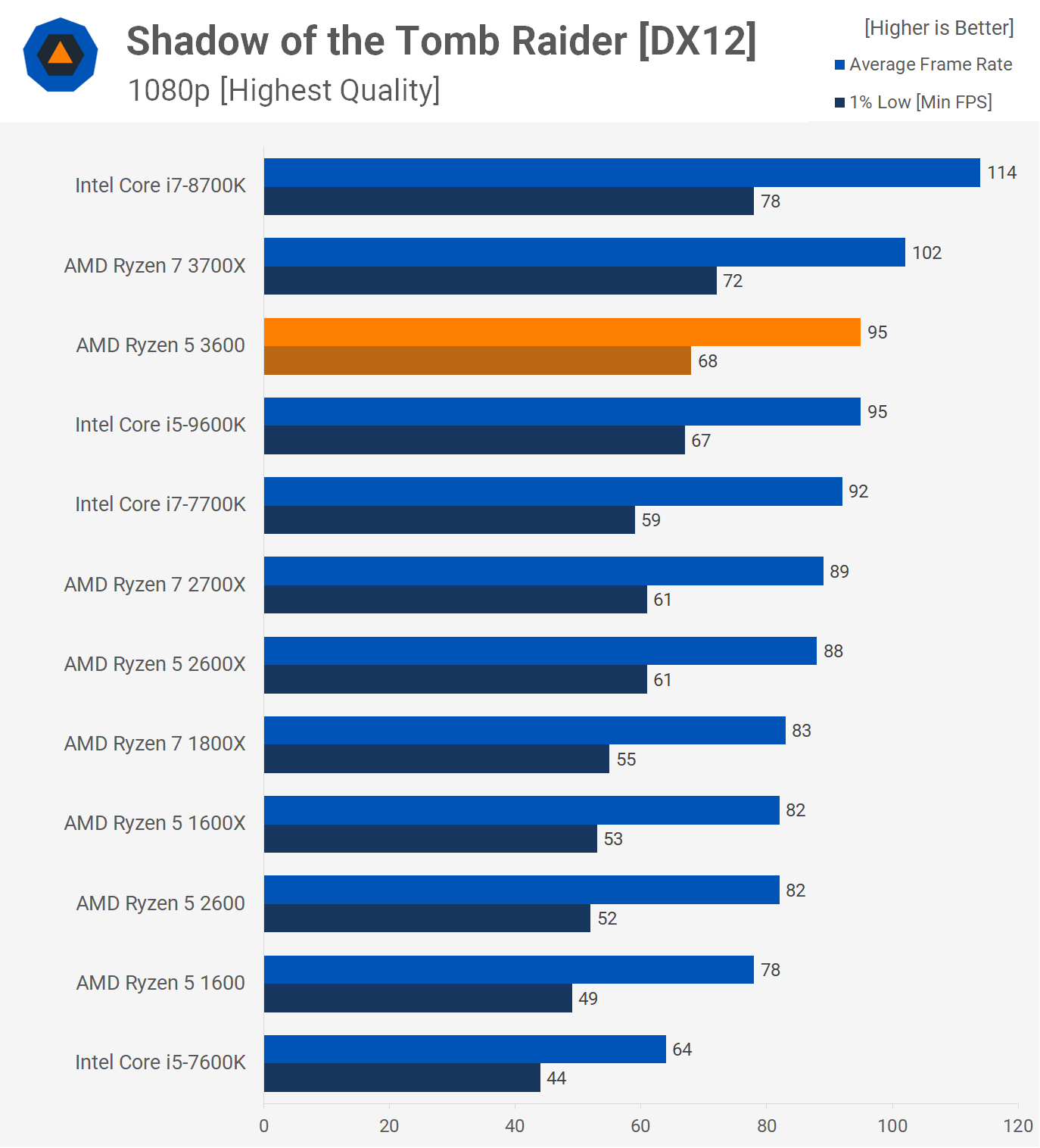
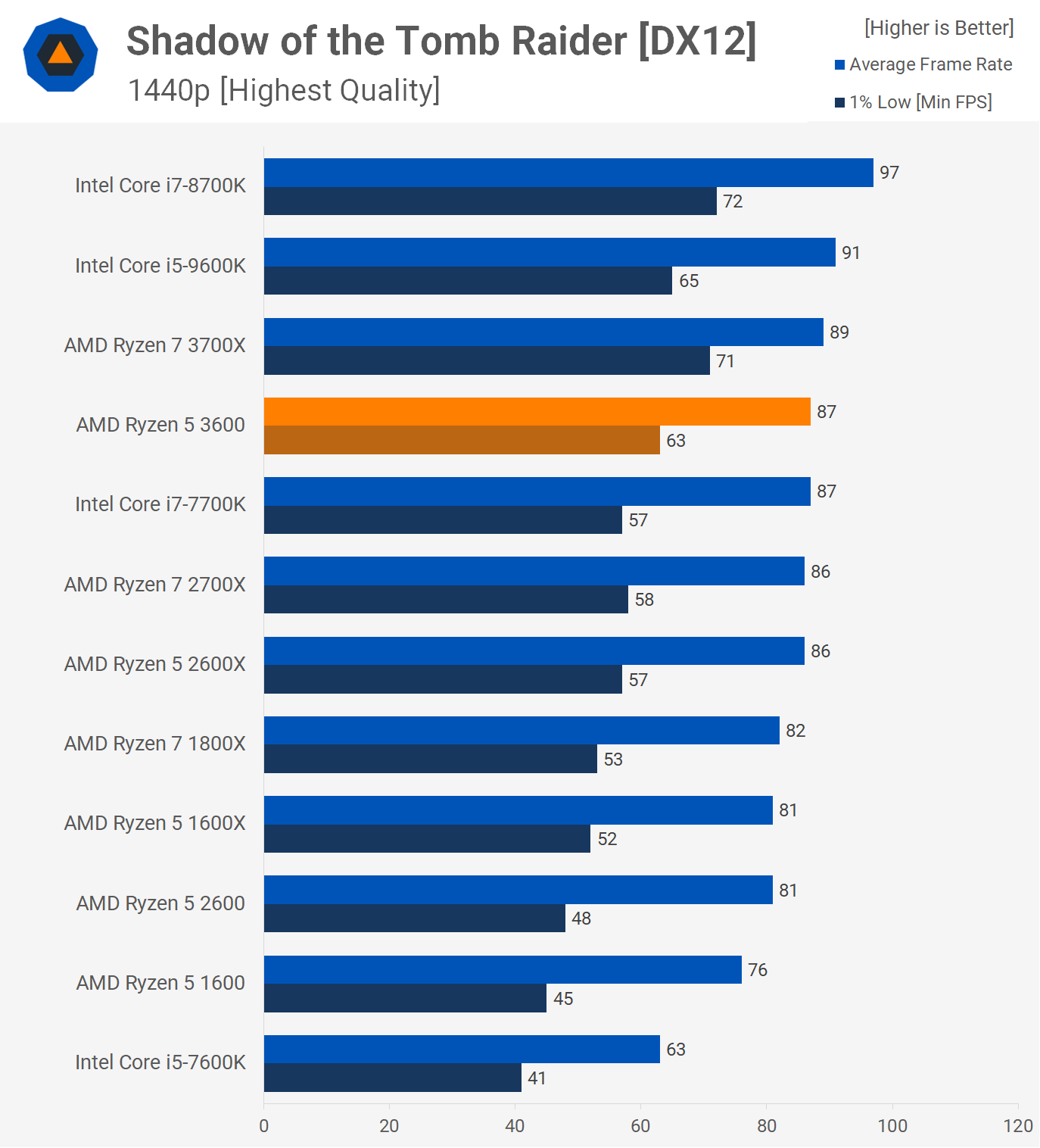
Moving on to The Division 2. At 1080p the R5 3600 edged out the 9600K and made a significant step forward from not just the 2600X, but also the 2700X. Interestingly, this time at 1440p the Ryzen 3600 was able to pull further ahead of the 9600K when looking at the 1% low performance. The R5 3600 was a good bit faster than the 2700X and 8700K here as well, as it matched the 8-core 3700X.
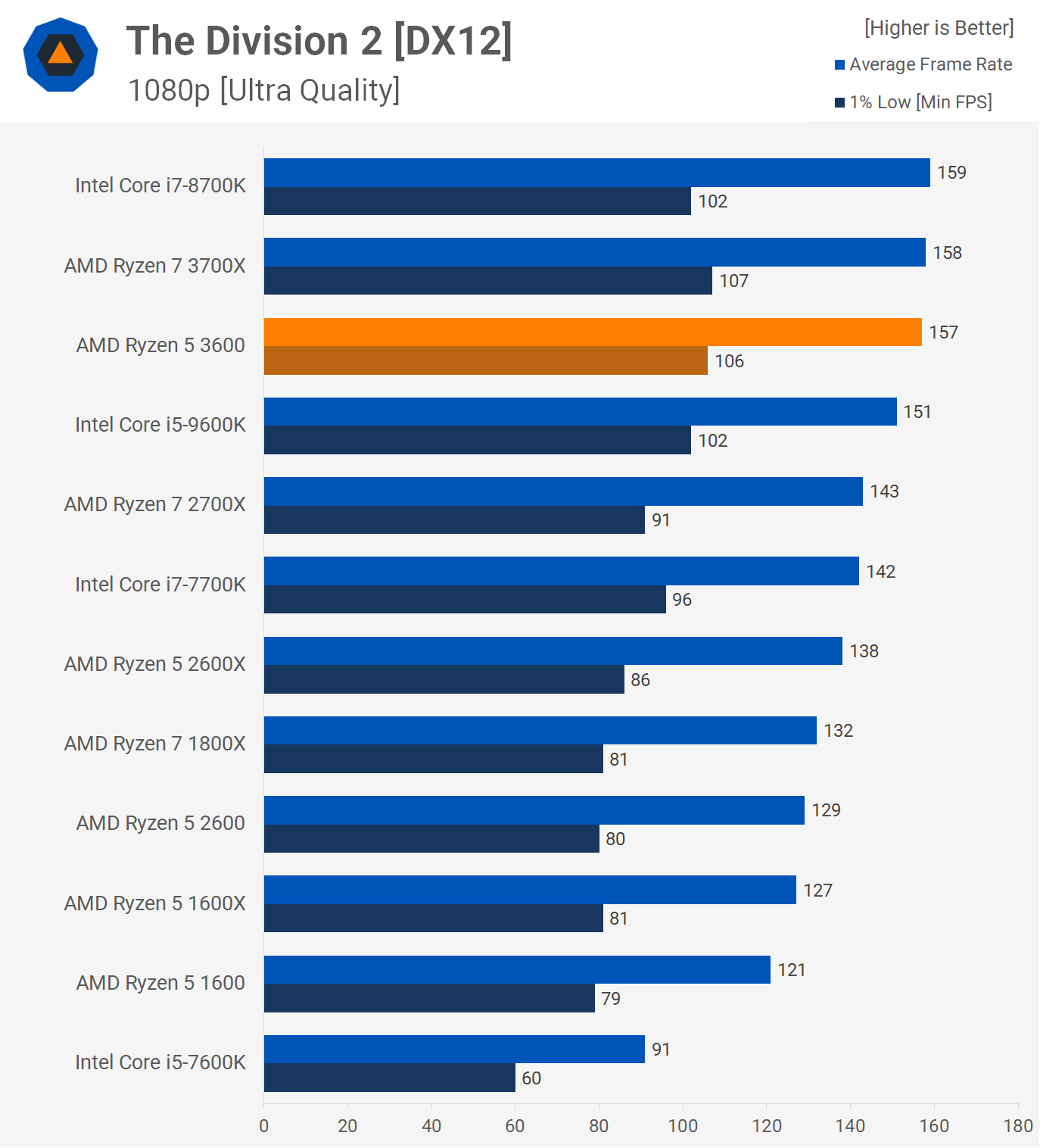
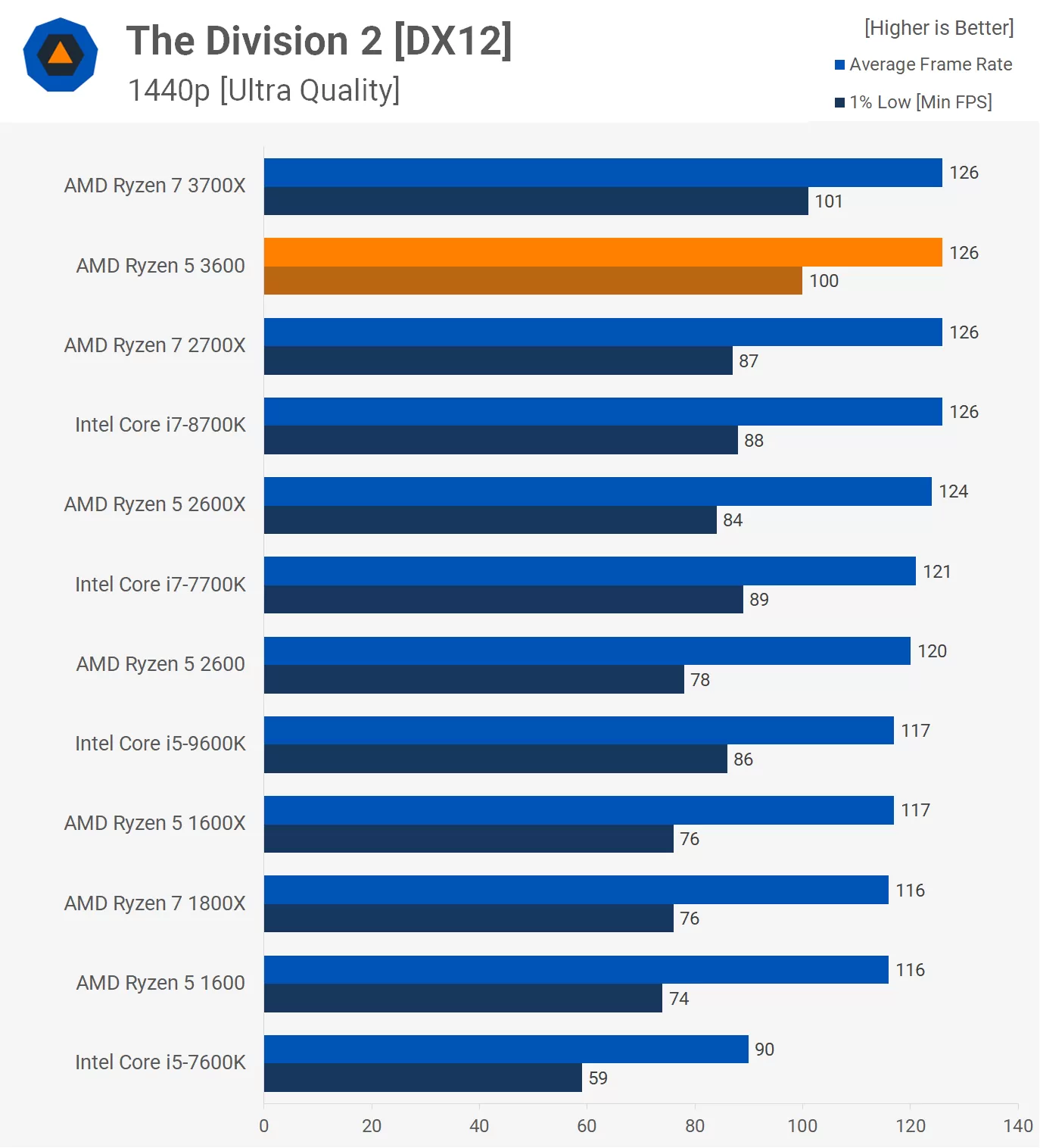
As we've come to expect from Ryzen, the performance in Far Cry New Dawn was not great relative to the competing Intel CPUs, overall gameplay was still smooth nonetheless. Even at 1440p the R5 3600 is still well down on the 9600K, particularly when looking at the 1% lows.

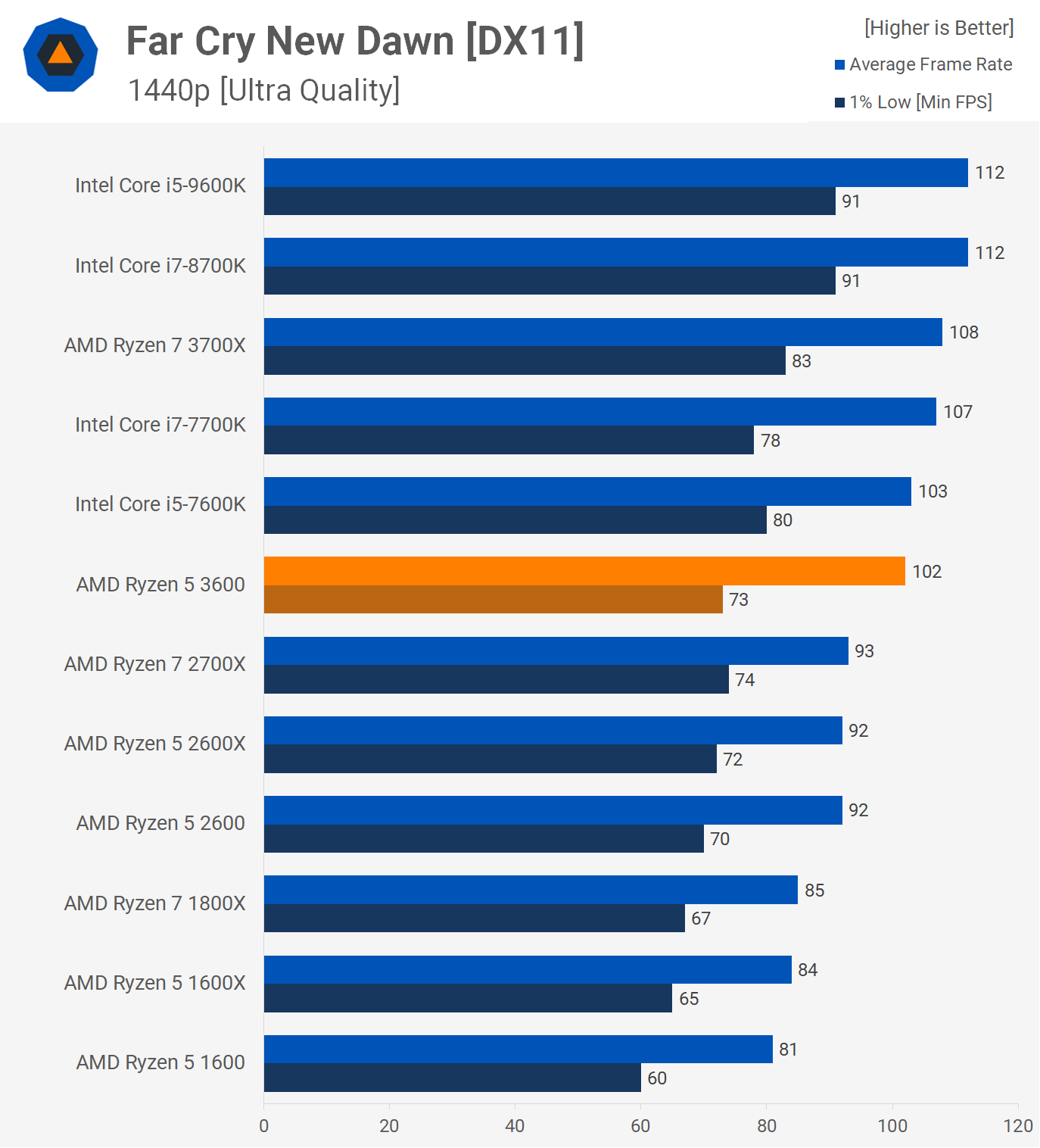
Performance in World War Z was also low relative to the Intel CPUs, but with well over 100 fps, it probably doesn't matter too much in this instance. The Ryzen CPUs create some kind of performance bottleneck in this title and we see what looks to be a 135 fps cap at 1440p, very odd considering the Intel CPUs pushed up to 150 fps.
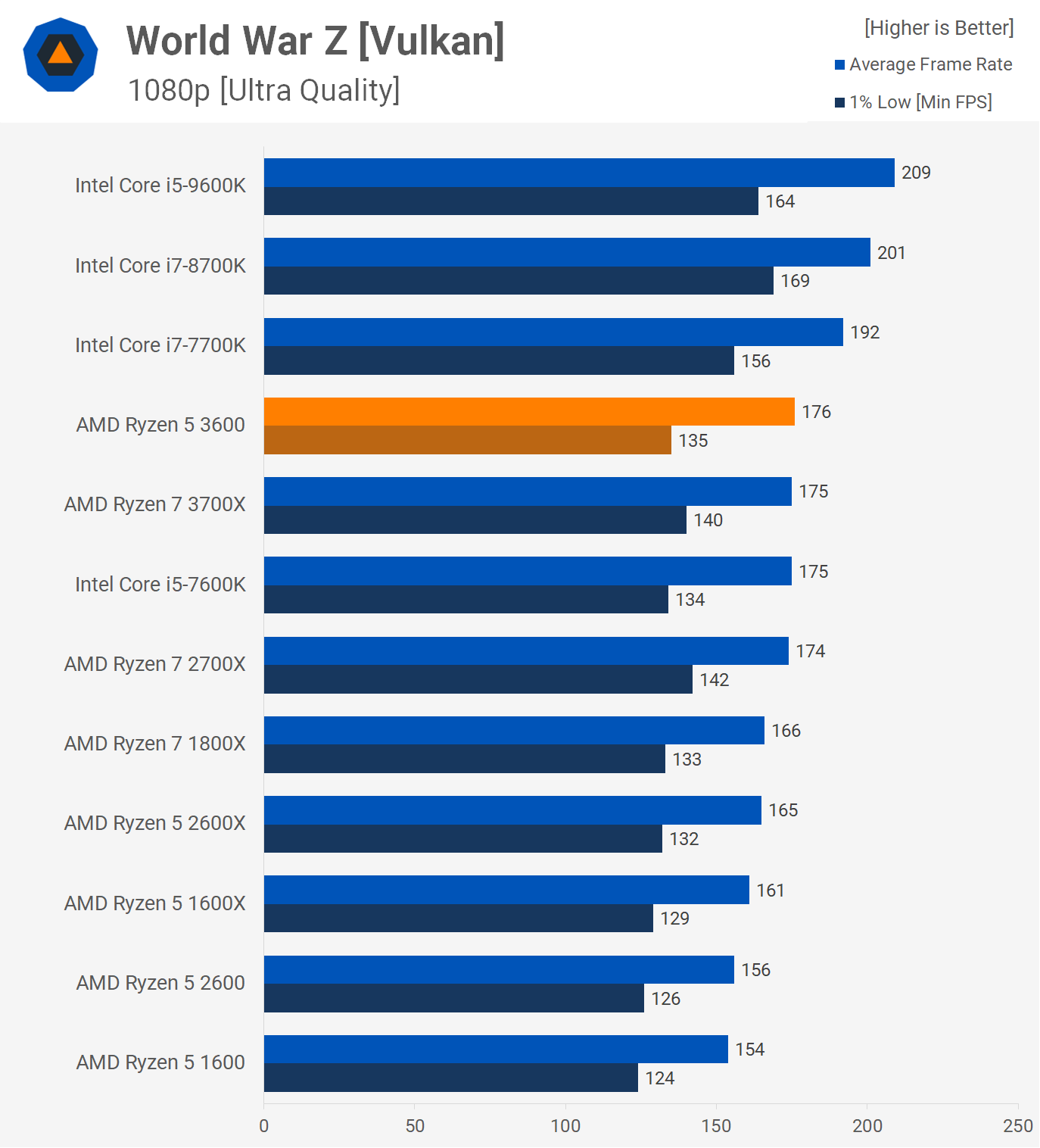
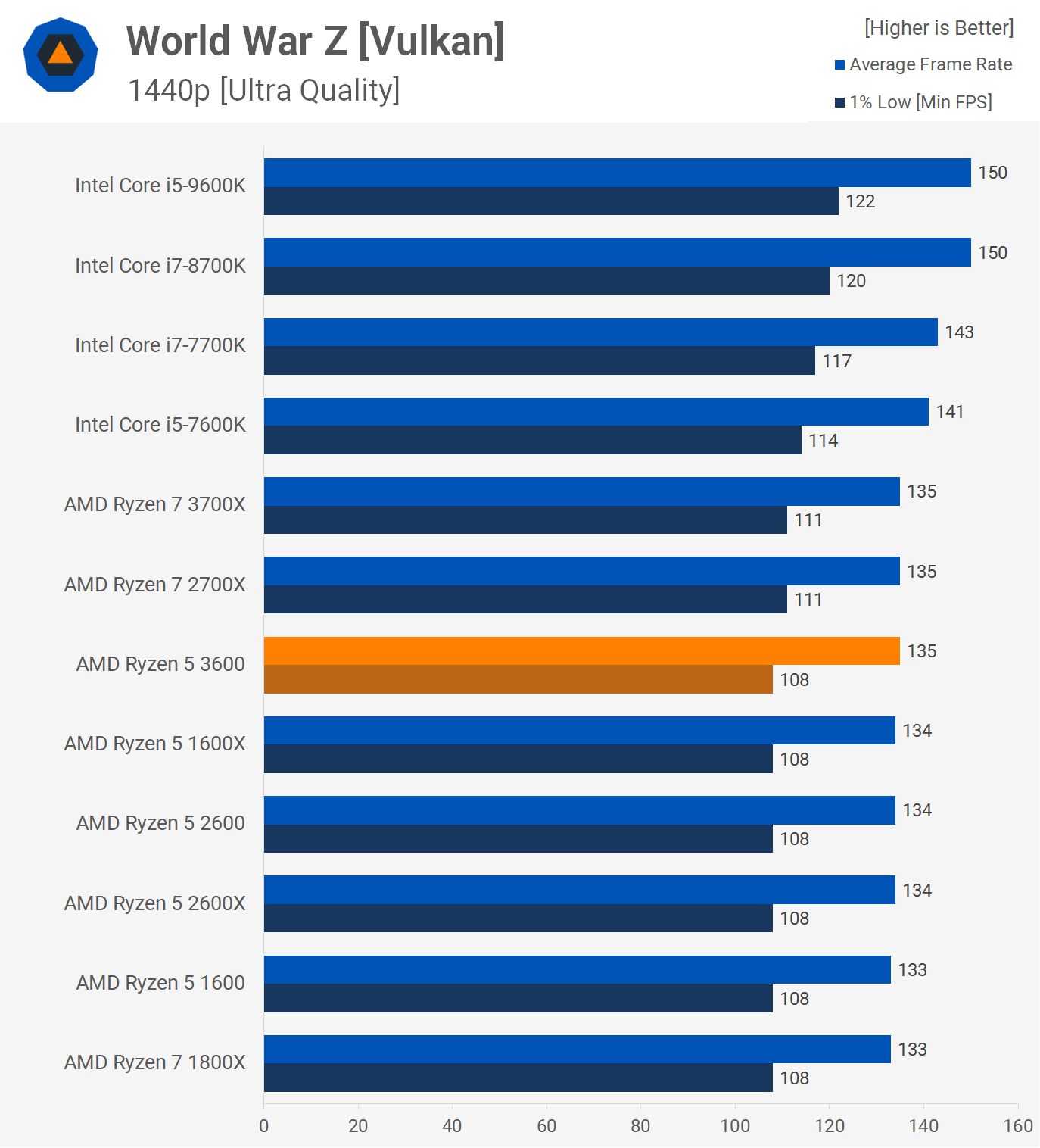
The Ryzen 5 3600 was solid in Rage 2, averaging 160 fps and that meant it wasn't a great deal slower than the 9600K. Moreover, the R5 3600 was fast enough to find the limits of the RTX 2080 Ti at 1440p, though this was true of almost all CPUs tested.

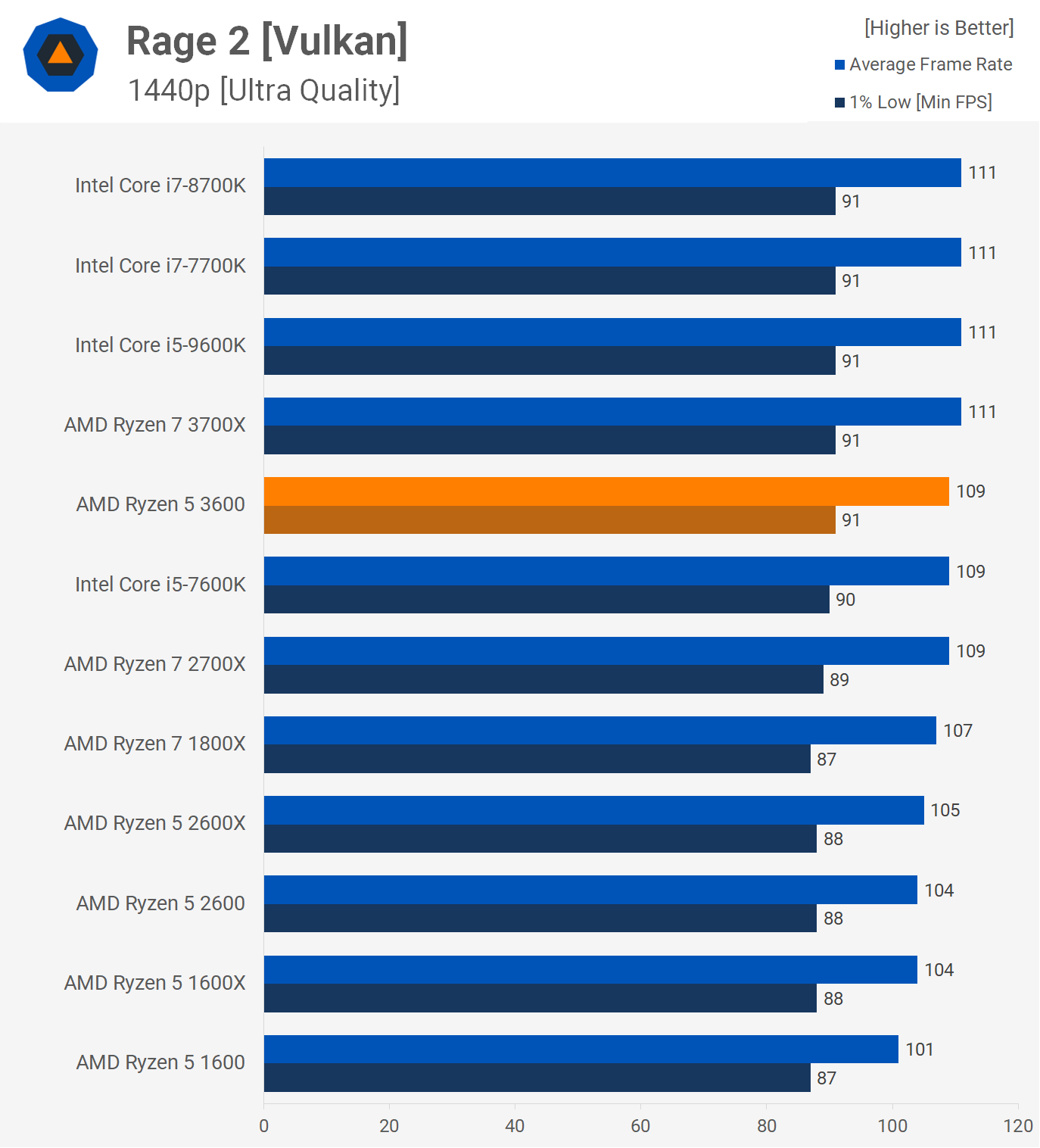
When testing with Hitman 2 we see that the R5 3600 was 7% slower than the i5-9600K when looking at the average frame rate, this isn't a great title for Ryzen CPUs.
We find similar results at 1440p, though here the 3600 matches the 1% low performance of the 9600K.

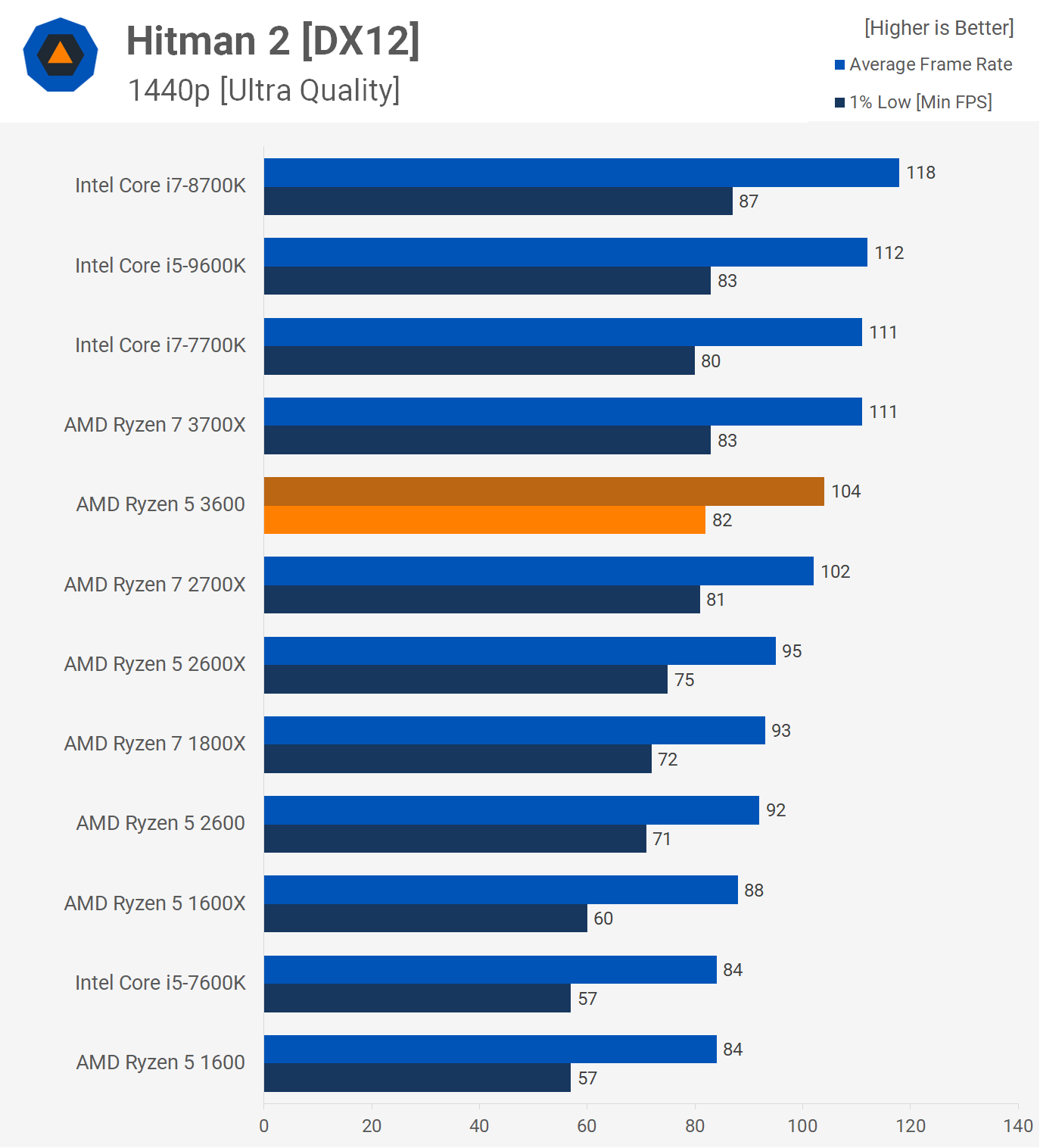
Finishing up the gaming benchmarks we have Total War: Three Kingdoms and here the R5 3600 offered stronger 1% low performance than the 9600K with a slightly lower average frame rate. But once we jump up to 1440p with the RTX 2080 Ti the performance margins are neutralized between the 9600K and 3600.
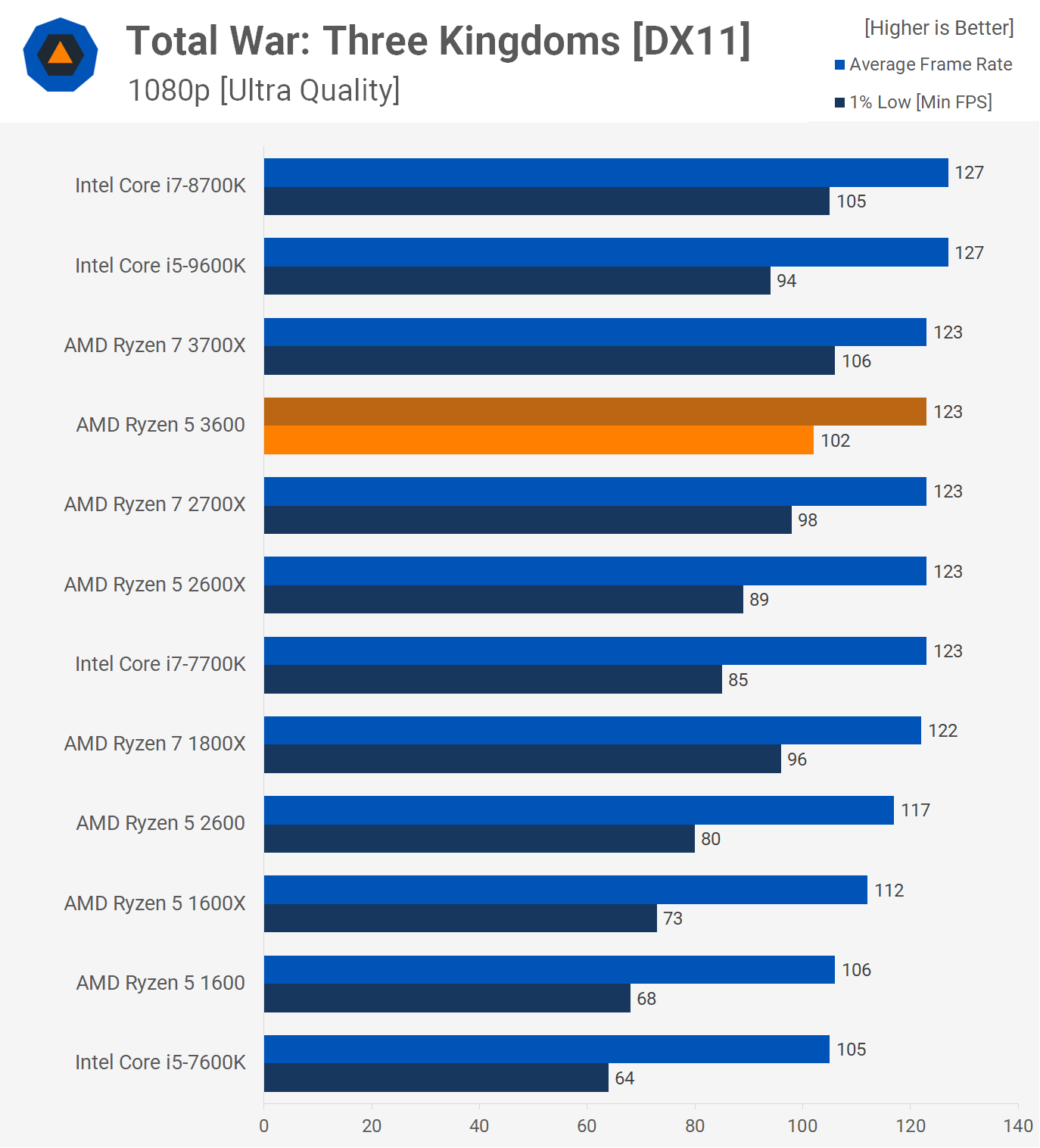

Overclocking
As was the case with the 3700X and 3900X, there's very little overclocking headroom to speak of with the Ryzen R5 3600. The best we could do with an all-in-one liquid cooler was a 4.2 GHz all-core overclock. Again, you're best off enabling the PBO + AutoOC feature in the Ryzen Master software. This boosted the Cinebench R20 multi-core score by a mere 4%.
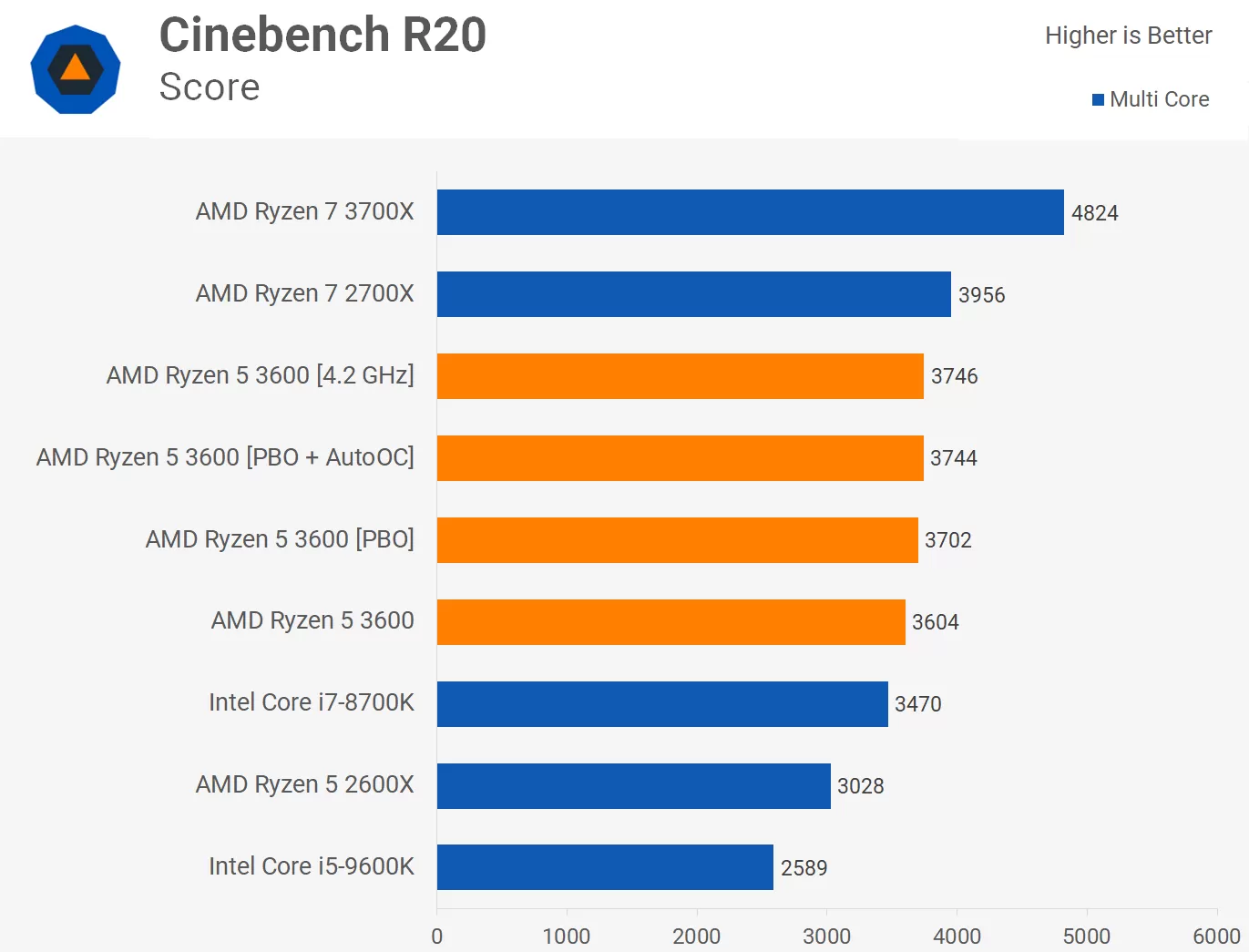
Here we see the PBO + AutoOC improved the single core score by 1.6%, so I suspect most won't bother with overclocking as it's not really worth the added heat. Speaking of which, let's check out the thermal performance of the included Wraith Stealth box cooler.
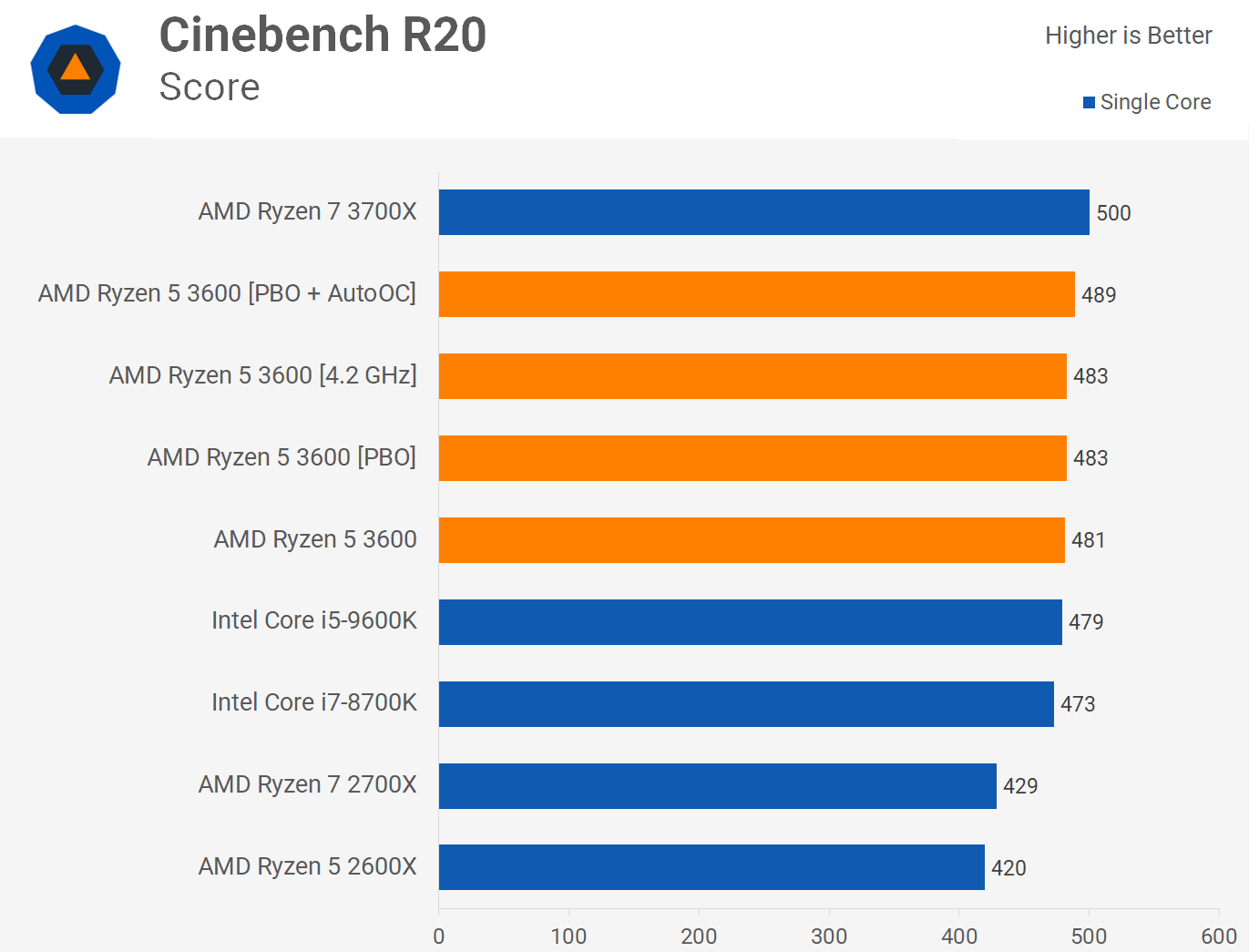
Thermals
With the Wraith Stealth installed the R5 3600 maintained a 4 GHz clock speed out of the box during our 1 hour long Blender stress test. This is an extreme stress test, so having it peaking at just 80 degrees is pretty good, especially given it was virtually silent.
You can enable PBO with the box cooler, but it won't do much as you're already near the thermal limit. Basically we gained 25 MHz for a 4 degree increase in temperature... needless to be said, we don't recommend using PBO with the box cooler.
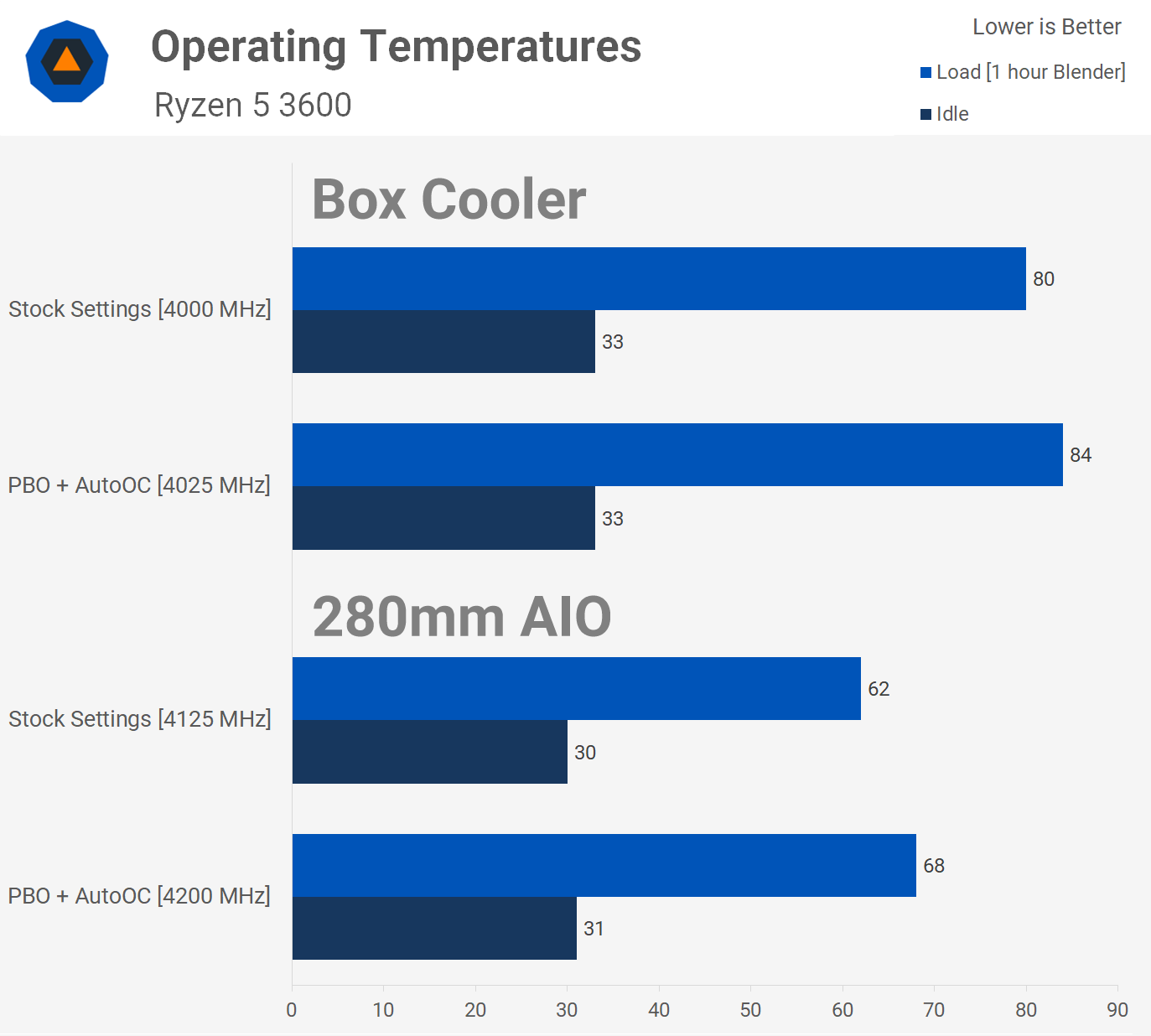
With a decent cooler installed, temperatures dropped quite significantly. You don't need something as extreme as the Corsair Hydro H115i, but we used this for the 3700X and we wanted a direct comparison. Anyway, with the AIO liquid cooler installed stock temps dropped to 62 degrees and now by default the 3600 ran at 4125 MHz, so a 3% auto overclock. Then with PBO enabled we got another 85 MHz and this increased the load temp to 68 degrees, which is still very cool.
Cost per Frame Analysis
For the cost per frame data we're adding the cost of a cooler to Intel systems. We decided a $40 budget for the Cooler Master Hyper 212 Black Edition is very reasonable. With those adjustments made the Core i5-9600K comes in at a total cost of $295 and that means the cost per frame figure is $2.18 which places it on par with the Ryzen 7 2700X.
The Ryzen 5 3600 comes out significantly more affordable at just $1.53 per frame as it delivers a similar level of performance, but costs almost $100 less. This makes the R5 3600 better value than the 2600X at its current $195 asking price, though it is 18% more costly than the vanilla R5 2600. Even so given the efficiency improvement and the absolutely monstrous uplift in productivity performance, we feel it's going to be easy to justify the small price premium.

Wrap Up
As predicted the Ryzen 5 3600 offers a tremendous value and because it sips power it'll work on even the most basic B350 motherboard, provided it receives the necessary BIOS update. Alternatively, for brand new builds you can grab our favorite B450 board, the MSI Tomahawk and you'll have a killer combo for a smidgen over $300. Basically what you'll pay for the 9600K with a mid-range cooler.
Then in the future your options are aplenty: Ryzen 7 3700X, Ryzen 9 3900X or maybe even a 16-core 3950X, who knows what second hand deals will be available on these parts in a few years' time. This is why we've been big proponents of AMD's AM4 platform. Those who bought in two years ago with an affordable B350 motherboard and say the Ryzen 5 1600, for example, you now have the option of slotting in the R5 3600 for up to a 35% performance boost in games and at least a 45% boost in applications, though as we saw in WinRAR it can be over a 100% boost.
But as we alluded to a moment ago, even for those building a new PC from the ground up, the R5 3600 looks like the best option. It smoked the Core i5-9600K in every single application benchmark we ran and worst case matches its single core performance. You get 12 threads opposed to just 6, so it's no doubt going to age better, but this time you don't have to roll the dice on Ryzen's longevity, as it's already faster today.
The Intel Core i5 was a little faster in a few of the games tested, but the R5 3600 was miles faster where you'll notice it. So this one's pretty cut and dry unless Intel decides to cut pricing heavily.
Later on we plan to test 3rd-gen Ryzen with some B350 motherboards to see just how well these new processors work on entry-level boards.
Shopping Shortcuts:
- AMD Ryzen 5 3600 on Amazon, Google Express
- AMD Ryzen 5 3600X on Amazon, Google Express
- AMD Ryzen 5 2600X on Amazon, Google Express
- AMD Ryzen 7 3700X on Amazon, Google Express
- AMD Ryzen 9 3900X on Amazon, Google Express
- Intel Core i5-9600K on Amazon, Google Express
- Intel Core i5-9400F on Amazon, Google Express
- GeForce RTX 2070 Super on Amazon, Google Express
- GeForce RTX 2060 Super on Amazon, Google Express
- GeForce GTX 1660 Ti on Amazon, Google Express
